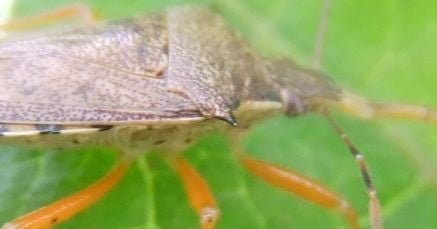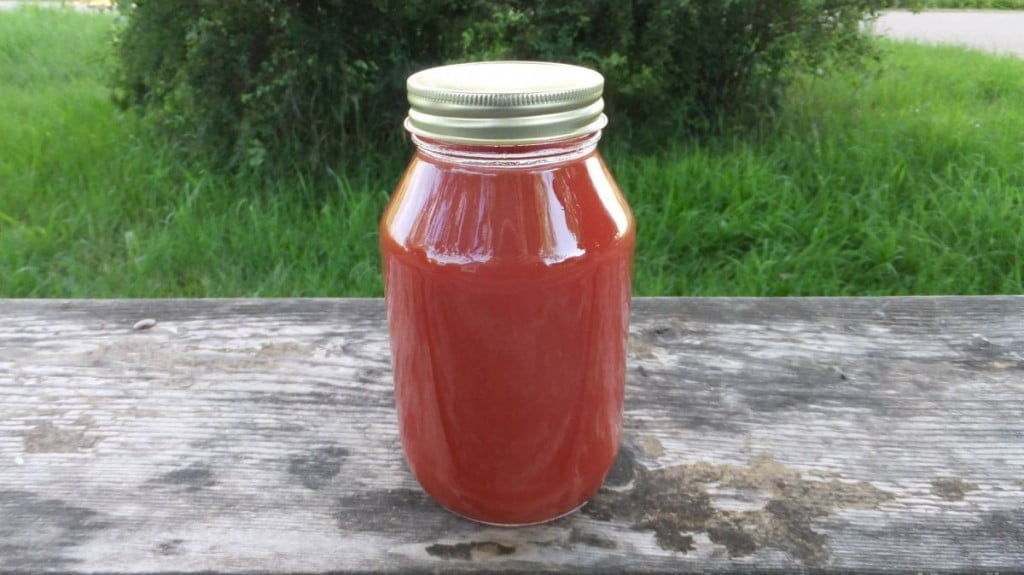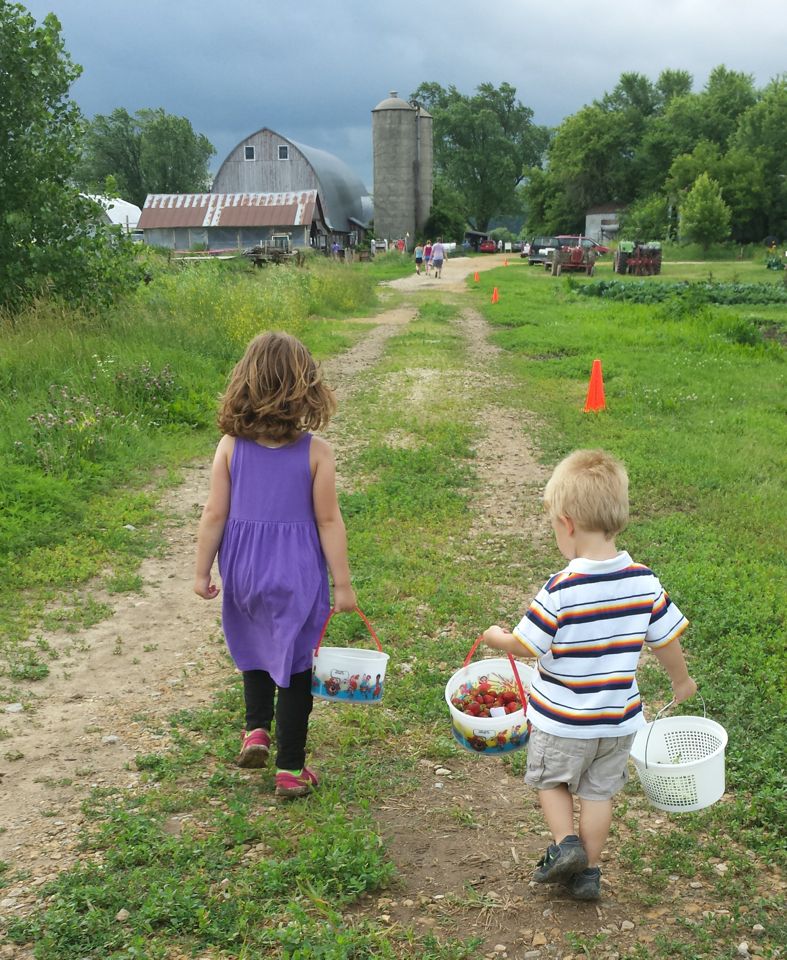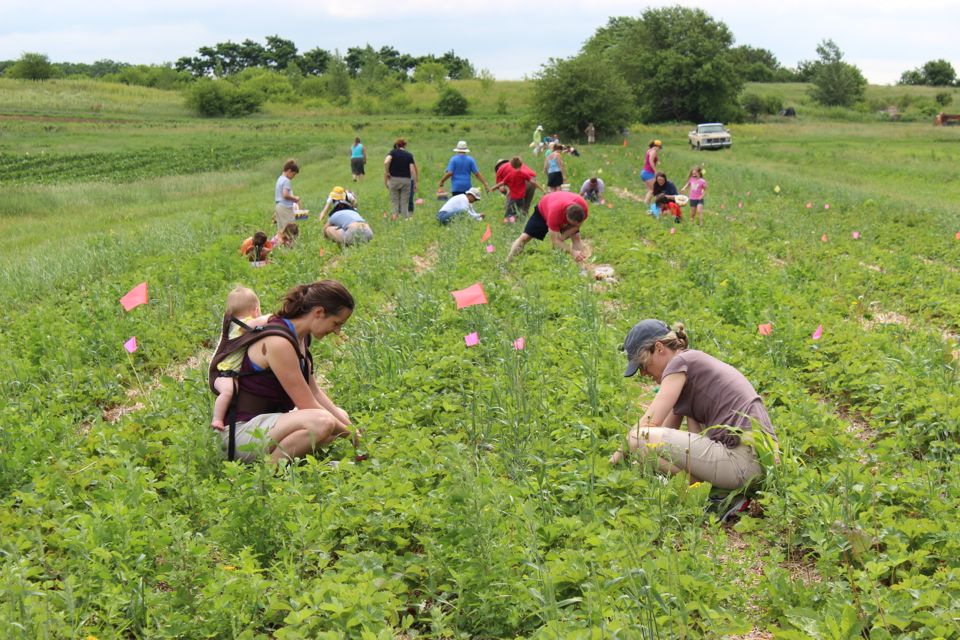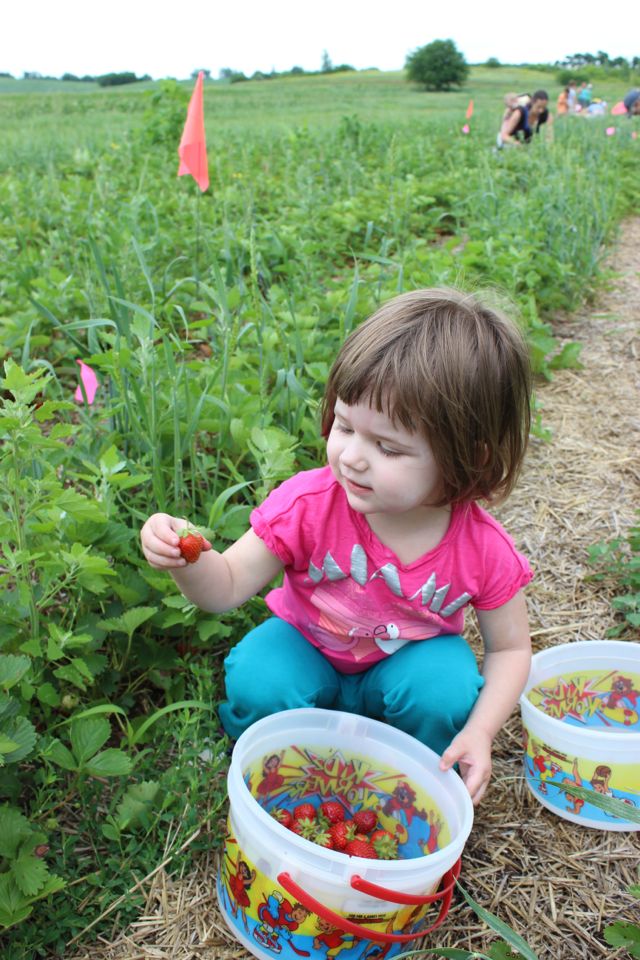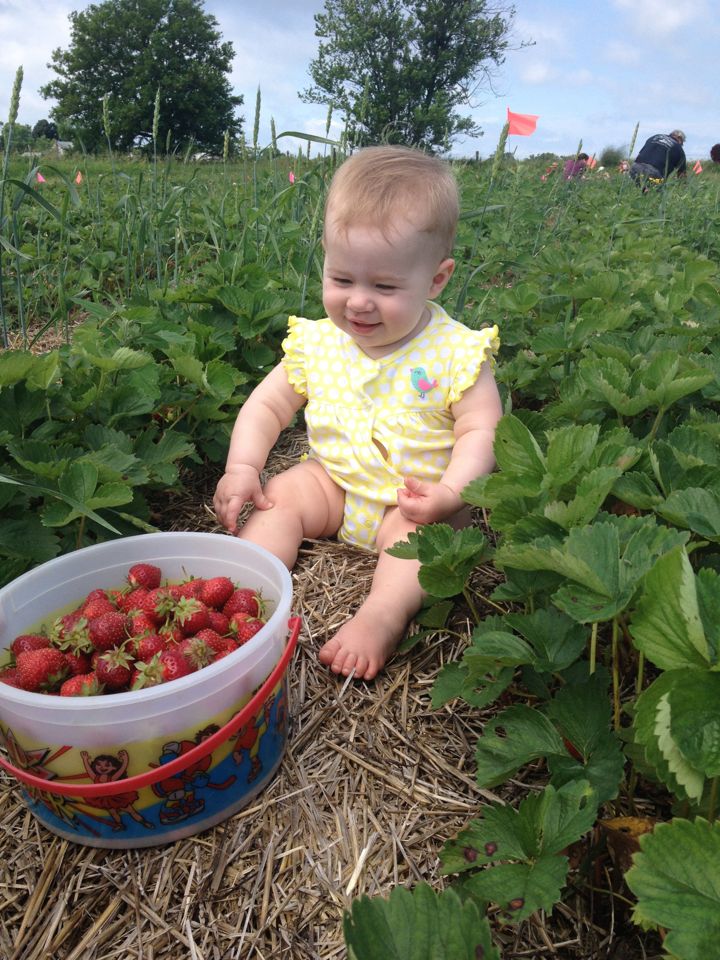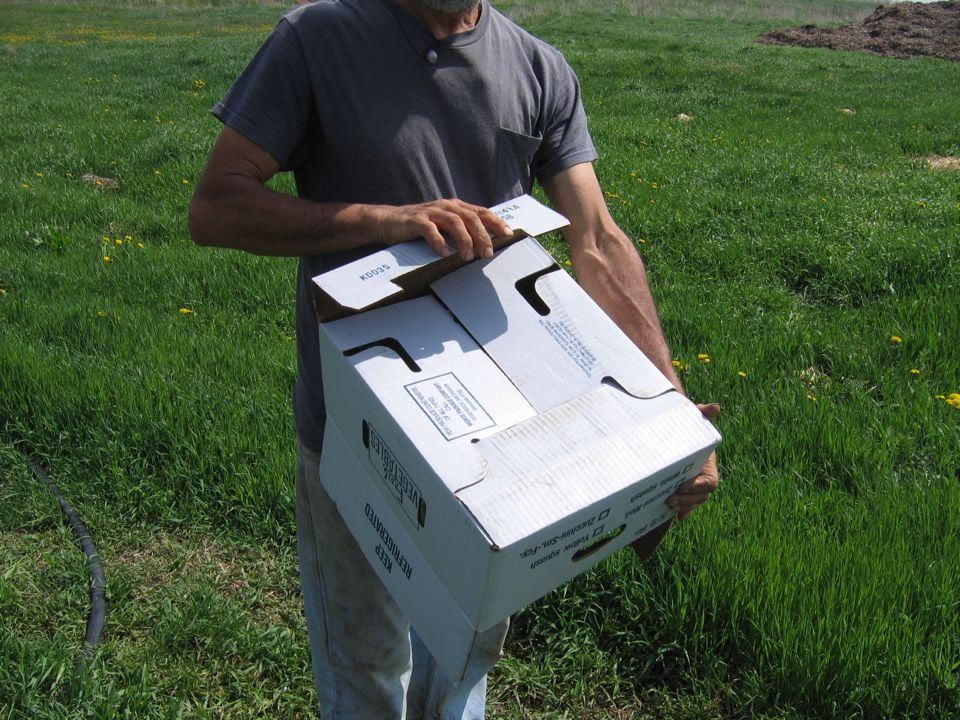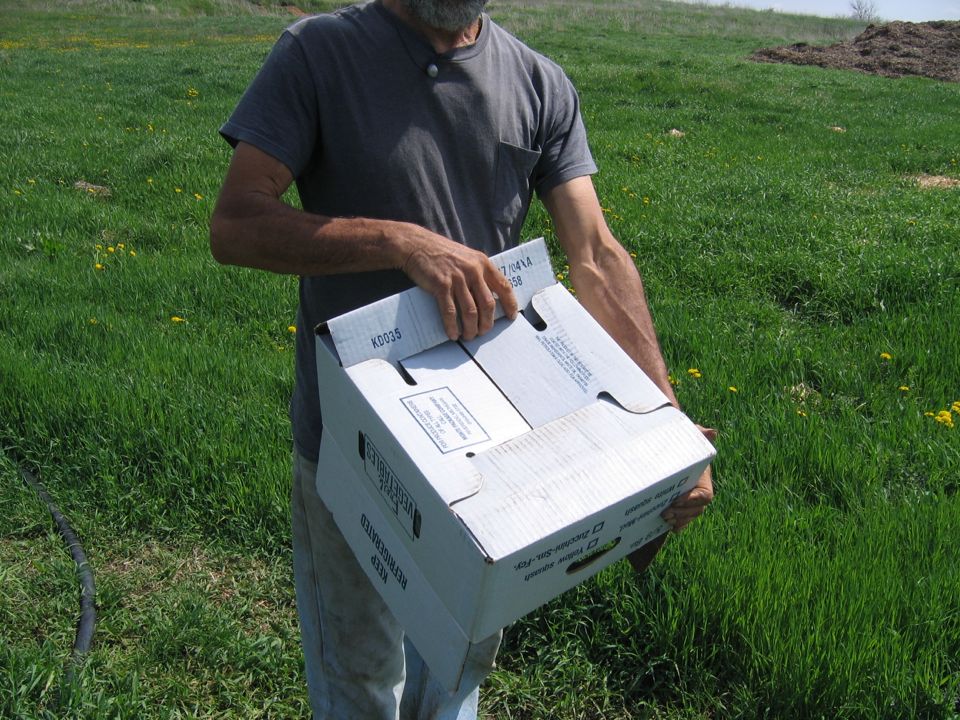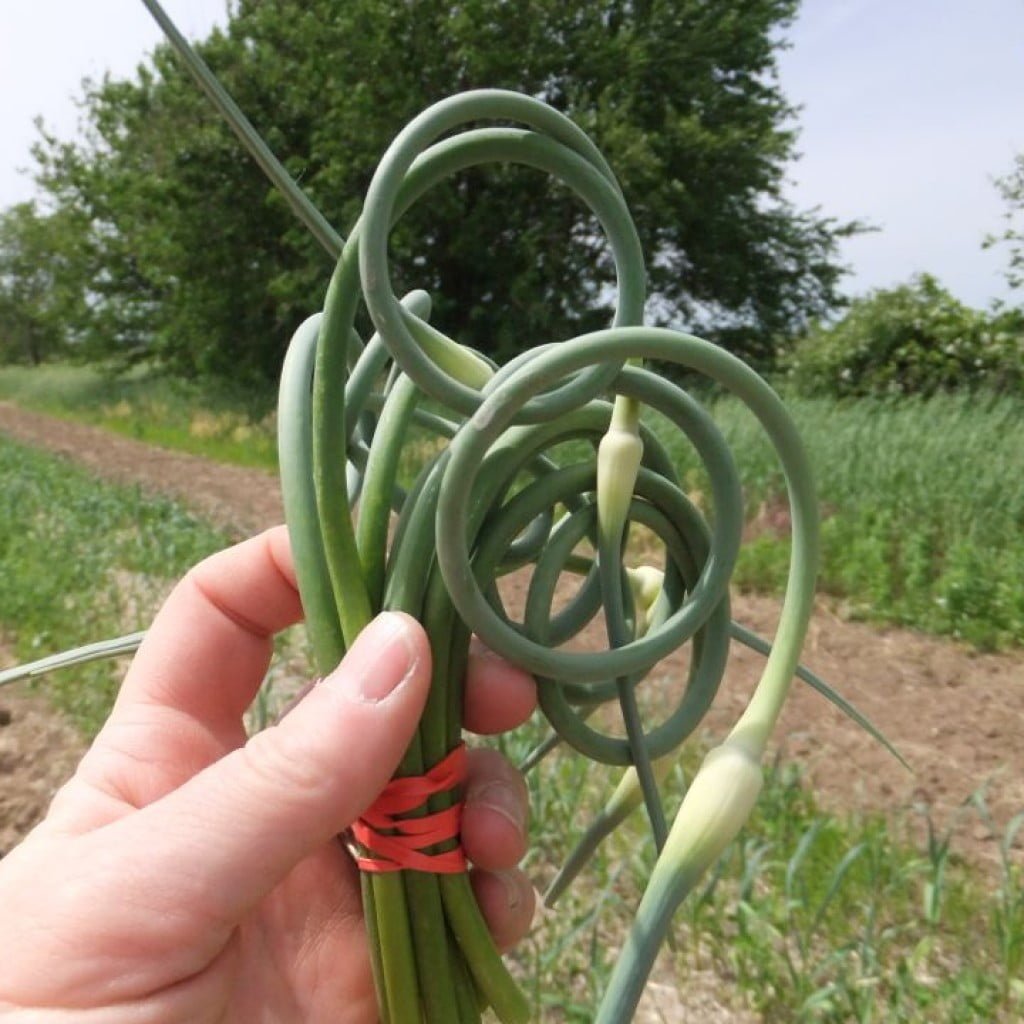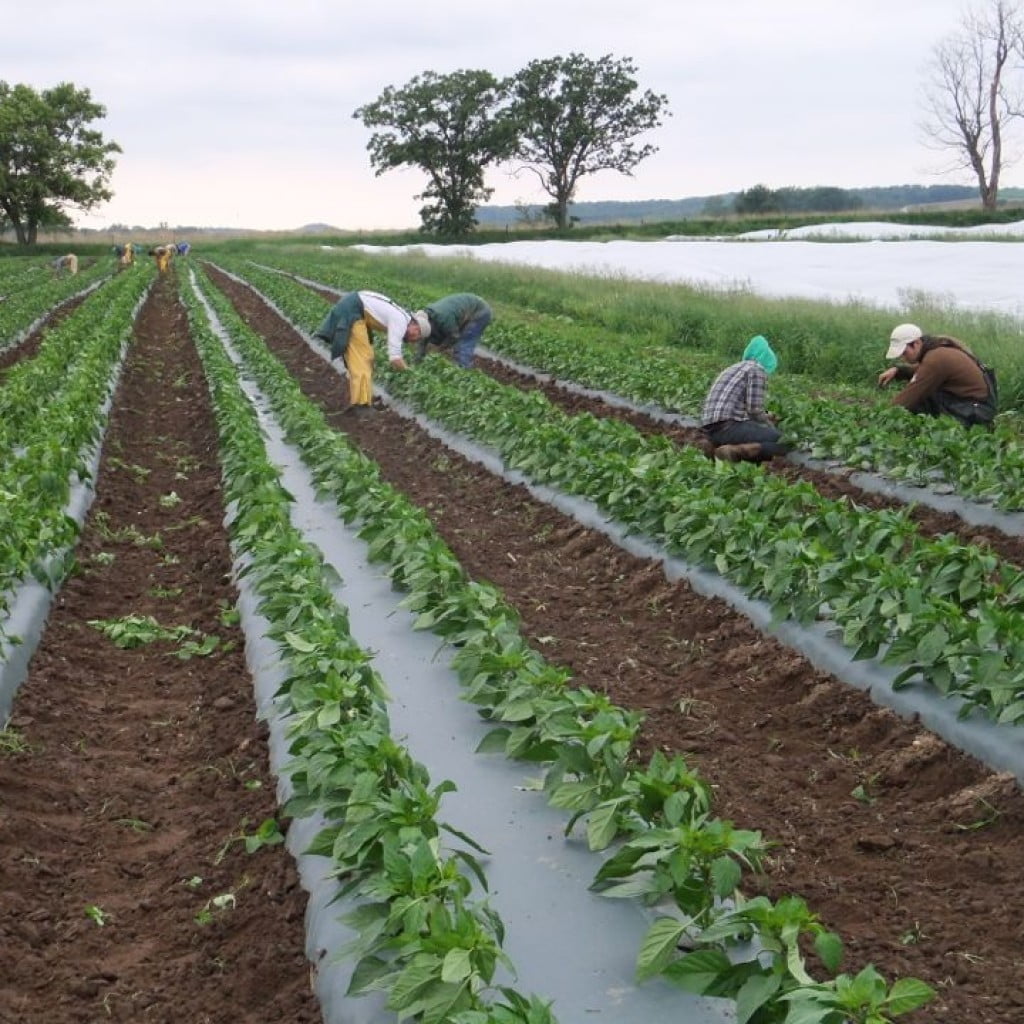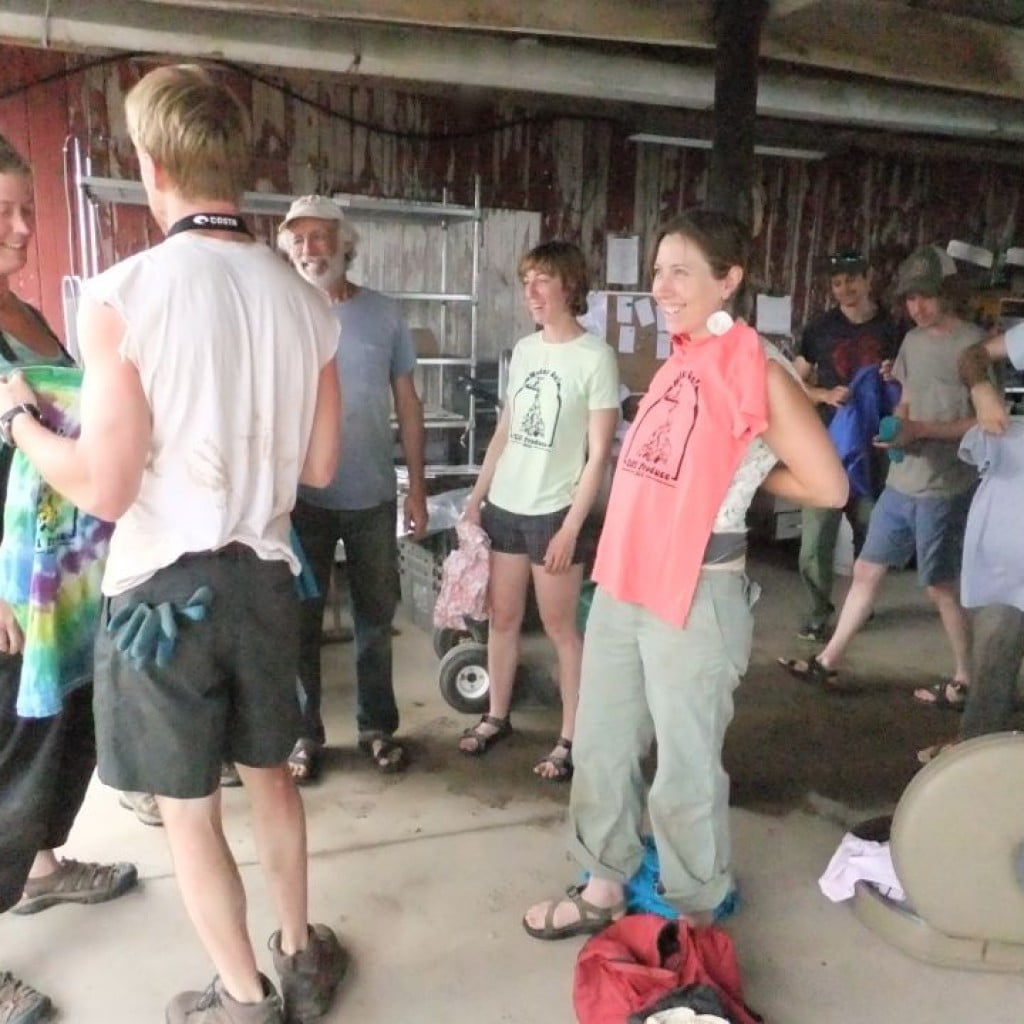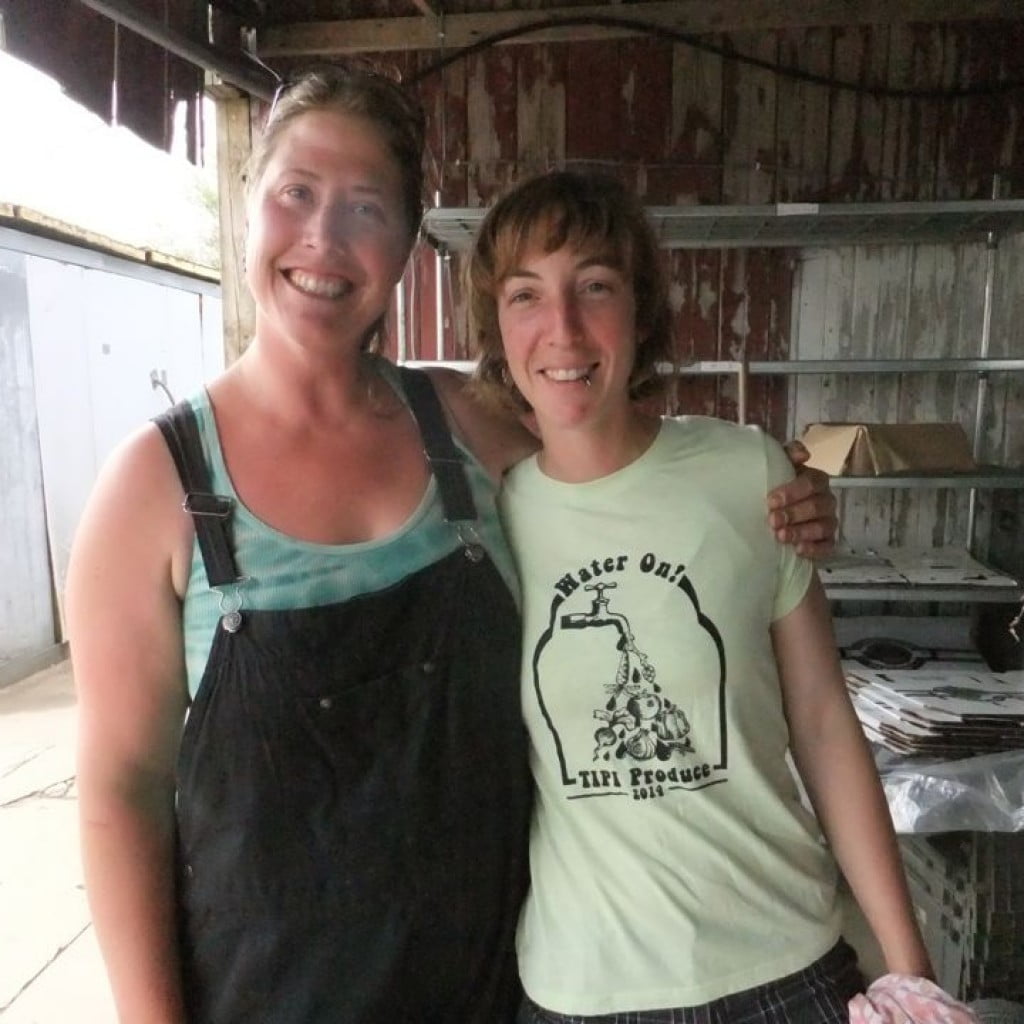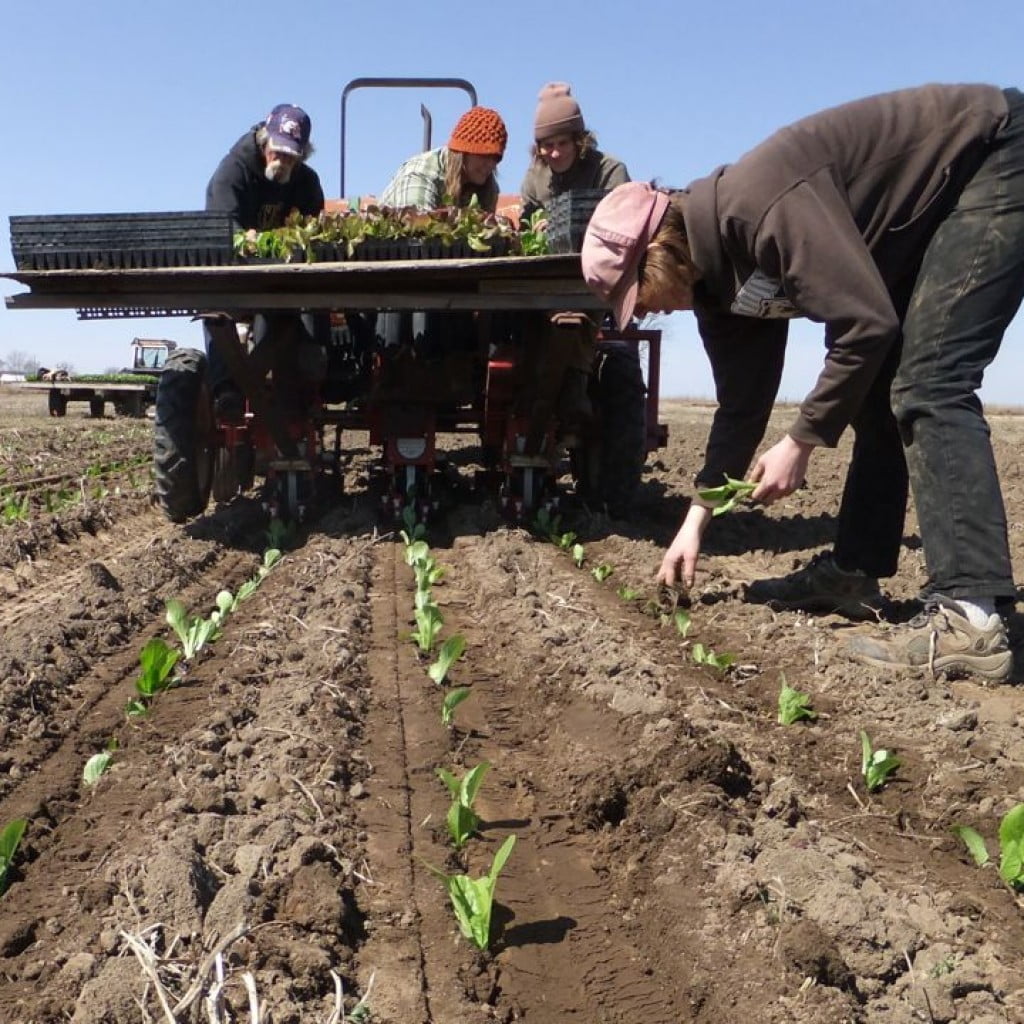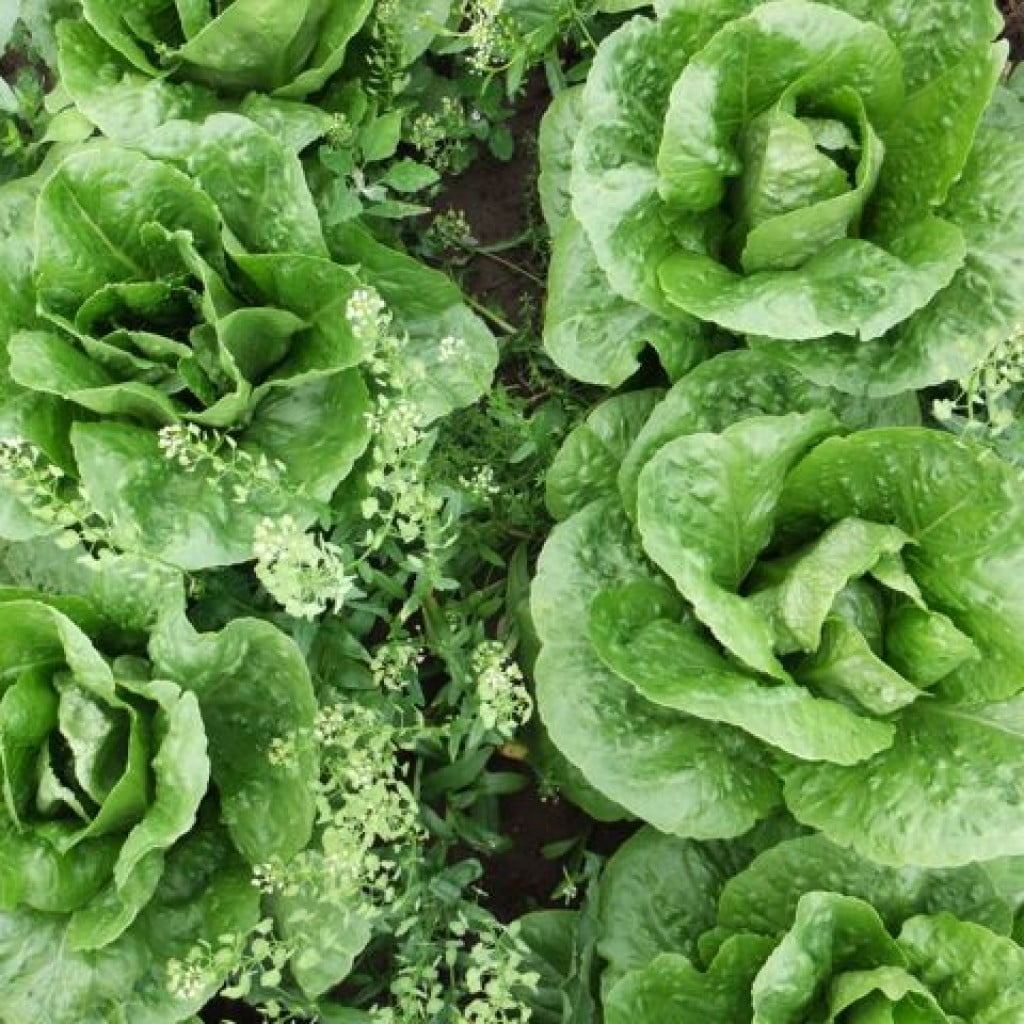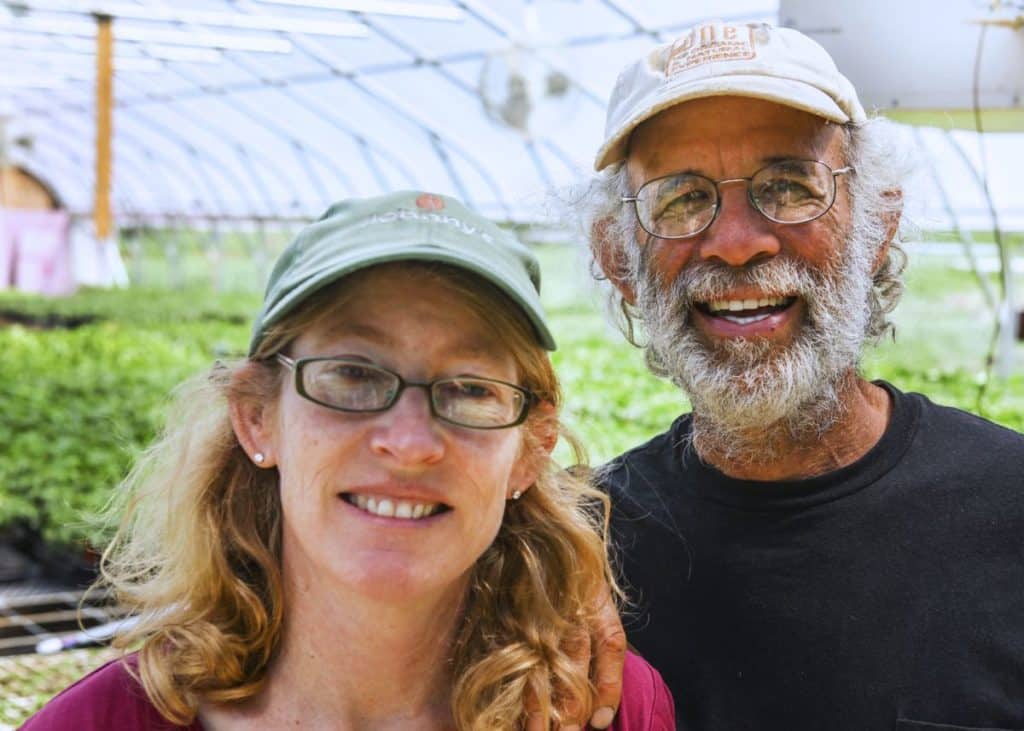Blog
Pretty edges
- On: August 06, 2014
 0
0
There are some lovely places on the lands surrounding our farm. Let’s take a look.
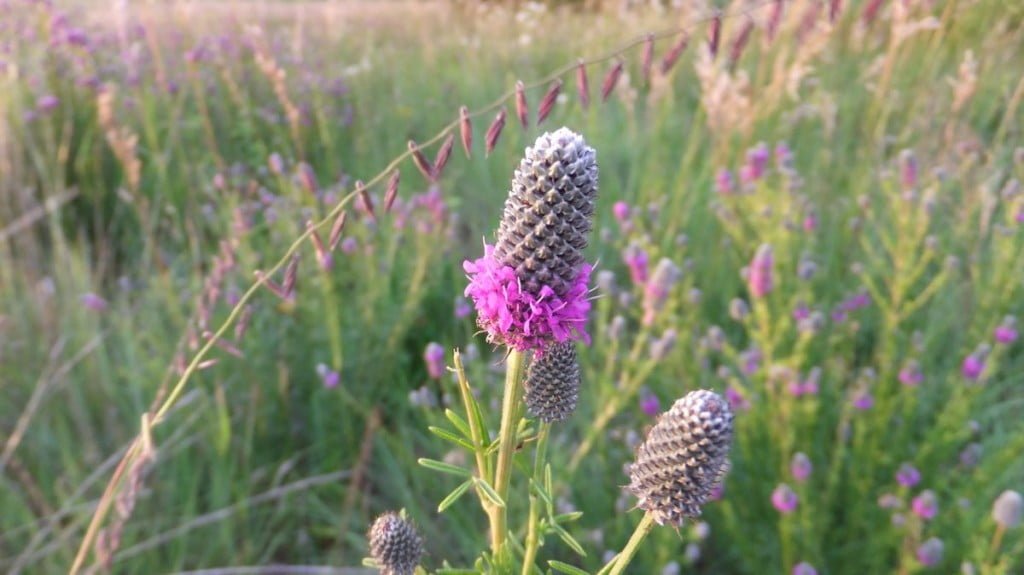
Purple prairie clover flowers, with dangling side-oats grama in the background.
Our neighbors planted a prairie strip along the border between our farms about five years ago. They said “We thought you wouldn’t mind.” They know our farm is certified organic. At 150 feet in width, the prairie strip is a substantial buffer for our crops. It’s a fascinating place to visit, even in winter.
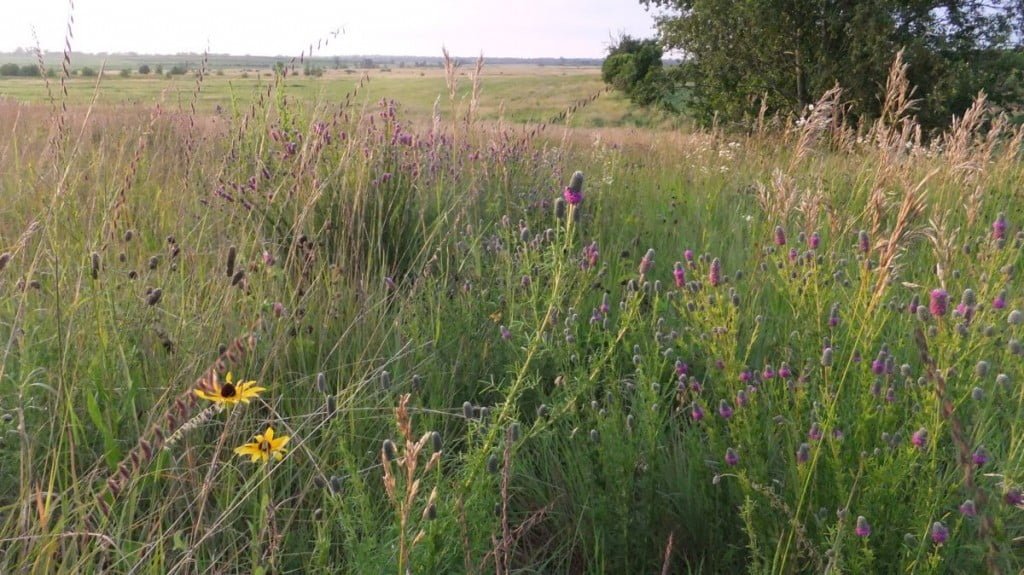
The prairie strip overlooks hunting grounds managed by the Wisconsin Department of Natural Resources (DNR).
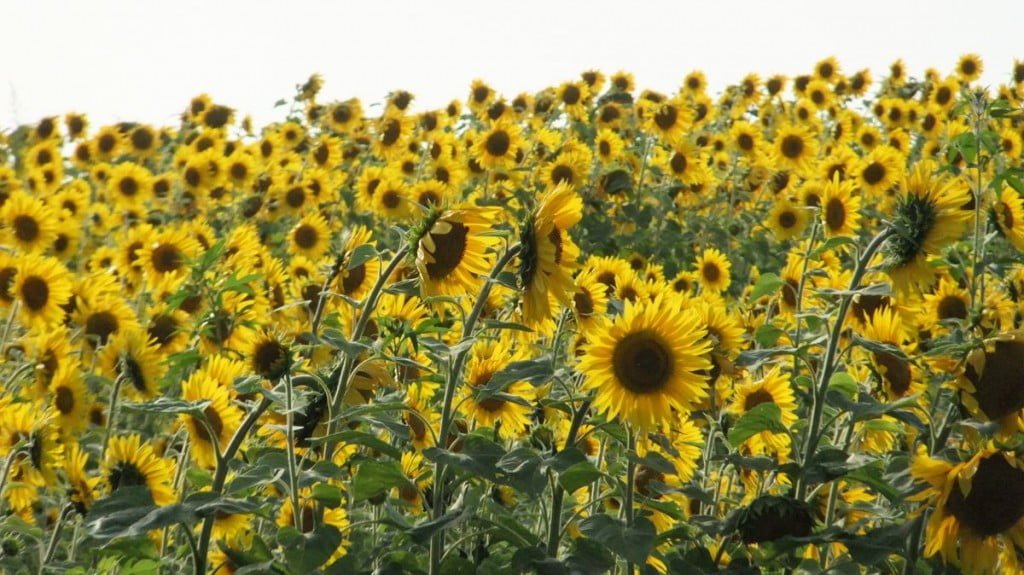
The DNR contracts with local farmers to grow sunflowers on some of those public lands. The sunflowers won’t be harvested. Instead, they will be left in the field to provide food for wildlife in fall and winter. See the DNR website for an article about annual crops that are useful for feeding wildlife. The article states that “sunflower seeds won’t last into the winter … as they are heartily feasted upon by ravenous songbirds during fall migrations.”

The sunflowers are so vivid at full bloom.
I’m back from vacation …
and ready to take emails again. Thank you, everyone, for limiting your emails while the kids and I were away. Steve is very busy while we are gone. It’s feels crazy to leave the farm for ten days at the height of the season. However, both our families live on the east coast. This summer trip allows our children to see their relatives more than once per year. I could not leave for that long with help from Steve and Kerry, my right-hand-woman in running the CSA. I appreciate their help so much.
Veggie List and Veggie Notes (8/7/14, week#12, purple EOW)
Red watermelon
Red slicing tomatoes, 2 to 2.5 lb
Red bell OR frying peppers, 2 or 3
Sweet corn, about 3 ears
Green beans, 1/2 lb
Carrots, 2 lb
Collards, 1 bunch
‘Summercrisp’ lettuce
White onion, 1
Red onion, 1
Cucumbers, about 2
Basil, 1 sprig
As long as we can fit them in the box, we will also send …
Zucchini & summer squash, 2 pieces
Next week, we hope to send melon, tomatoes, peppers, carrots, sweet corn, beans, onions, cucumbers, an herb and more.
Sweet corn – Much of this week’s corn is from a new planting, and the ears are on the young side. It won’t need much cooking. It was an exacting harvest and there may be some underripe ears mixed in. Our apologies in advance if you get one of them.
Collard greens – Summer greens are tougher than greens harvested during cool spring weather. Cook these longer than the spring collards.
Onions – We’ve sent a yellow Walla Walla onion for raw eating, plus a red onion for raw or cooked dishes. The red onion should fry nicely.
Cucumbers – We have a small planting of a new, white cucumber called ‘Silver Slicer.’ It is interesting and tasty. We don’t have enough for everyone this week, but we will try to distribute them to all the sites over the next few weeks.
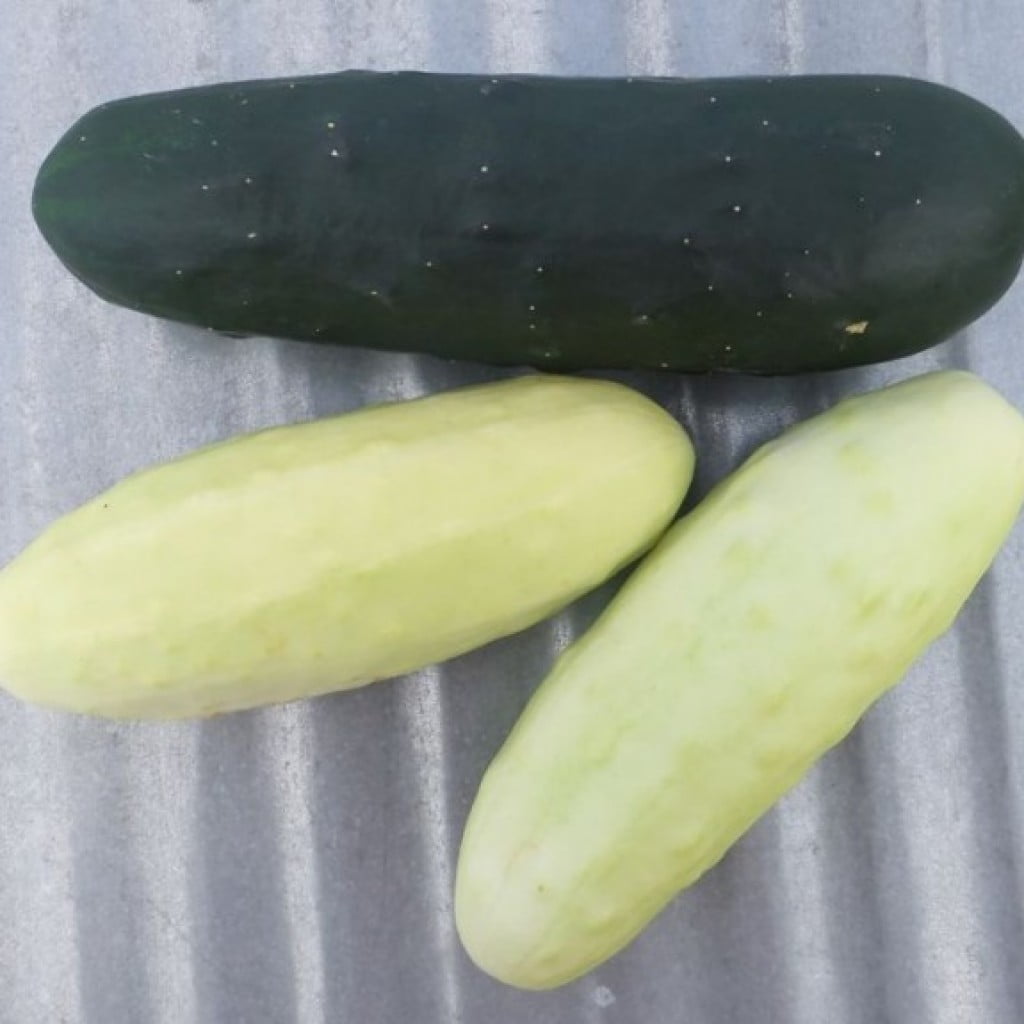
One traditional green cucumber and two ‘Silver Slicer’ cucumbers.
Veggie List (7/31/14, week #11, green EOW)
- On: August 05, 2014
 0
0
Sweet corn , 8 ears
Muskmelon OR Yellow Doll watermelon
Green beans, 1.5 lb
Cherry tomatoes, 1 pint
Red leaf lettuce
White onion, 1 large (1+ lb)
Green bell pepper, 1 large
Zucchini/summer squash, 2 lb
Cucumbers, 2
Basil
Eggplant OR broccoli OR red slicing tomatoes
Cool bug drama
- On: July 23, 2014
 0
0
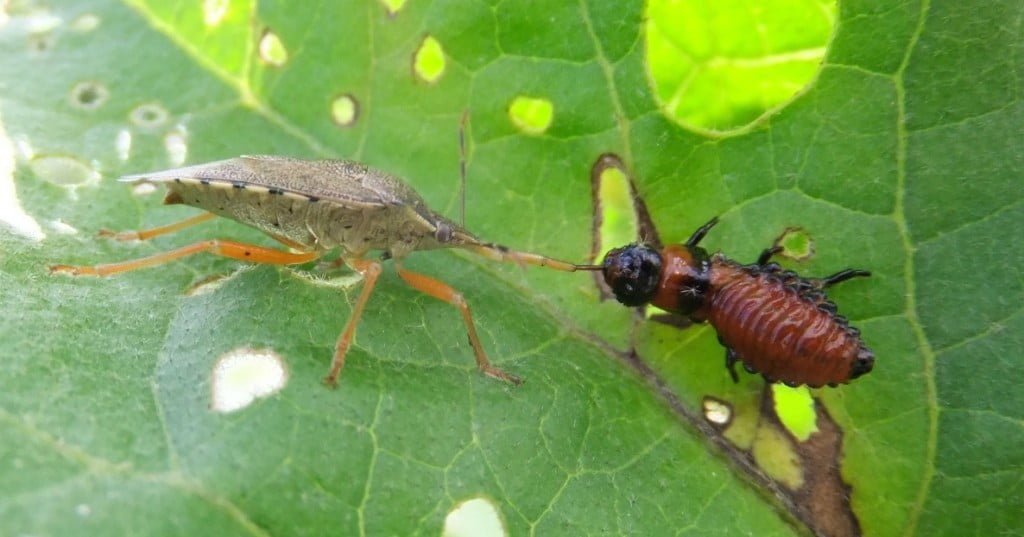
Spined soldier bug attacking a Colorado potato beetle larva.
I discovered this miniature battle among our eggplants. I was scouting for Colorado potato beetles, a pest that can defoliate eggplants. The attacking insect on the left is a spined soldier bug, a type of stinkbug. Most stinkbugs feed on (and damage) vegetables. However, the spined soldier bug feeds on other insects, especially Colorado potato beetles. This is so helpful! You can distinguish a spined soldier bug from other stinkbugs by the spines on its “shoulders.” Sucking out the brains of Colorado potato beetles is another clue. It was so cool to see this happening. This is organic agriculture at work, but it’s so easy to overlook.
CSA housekeeping
– Email brown-out from noon July 25 to August 4. I am taking our children to visit family on the east coast. We ask that you limit communication with us from July 25 through August 4. Please contact us no later than 12:00 noon on July 25 to ask questions, cancel a box, etc. Steve will check my emails but won’t have much time to respond. I’ll be back and ready to communicate on August 4. Thanks for your help with this.
– August 1 checks. Many of you paid us with checks dated August 1. I will deposit the checks on August 8.
Support a family in need.
Steve and I are members of FairShare CSA Coalition, a group of local farmers dedicated to promoting the CSA idea in Wisconsin. Our vibrant Partner Shares program supports CSA shares for low-income households. We thank each of you who donated to Partner Shares while registering for your Tipi CSA share this year. In hopes of expanding the number of families we can support next year, FairShare is holding a donation drive from July 21 through August 8. FairShare writes “We believe every family should have access to locally produced, organic food. Unfortunately, for many people, purchasing local, farm-fresh, food is beyond their means. The Partner Shares program brings fresh produce within reach for low-income families by providing up to $300 toward the cost of their CSA share.”
As you enjoy the produce we’ve grown for you, we invite you to share this experience with others in your community. Please donate to the Partner Shares program and “Share a Share” today. For more information about Partner Shares and how you can donate please visit FairShare’s website: www.csacoalition.org/news/partner-shares-donation-drive-july-21-august-8/. Thank you.
Bike the Barns registration is open but filling quickly.
Another way to support Partner Shares is by participating in the Bike the Barns bicycle tour. This year’s ride heads northeast of Madison, with two routes (45-mile, 60-mile), interesting farms, and excellent food. Read more and register here. The ride usually sells out by August 15, so you should make your decision soon.
Farm news
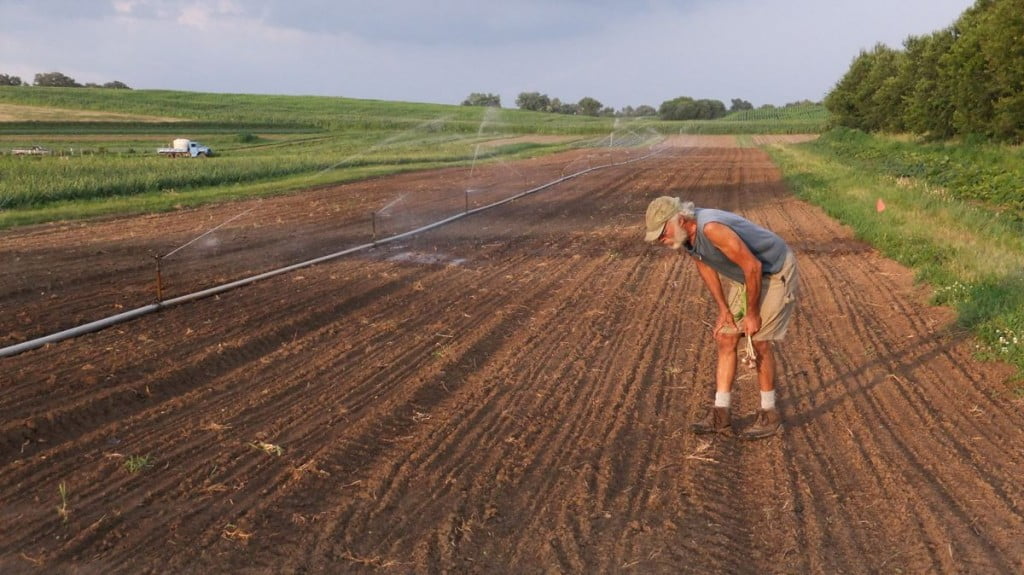
Steve irrigates a young carrot planting, and checks for emerging carrot seedlings. Carrots need to stay moist for 12 days after planting in order to germinate and emerge well. Rain is wonderful. Irrigation is reliable. We’ve had good germination in our carrot plantings this month because of the frequent rains. The carrots we plant in July will be ready to harvest in October and November. We’ll store the carrots for sale through the winter to the Willy Street, Outpost and Basics coops. I showed a photo of this exact field earlier this spring. It was planted to lettuce and scallions then.
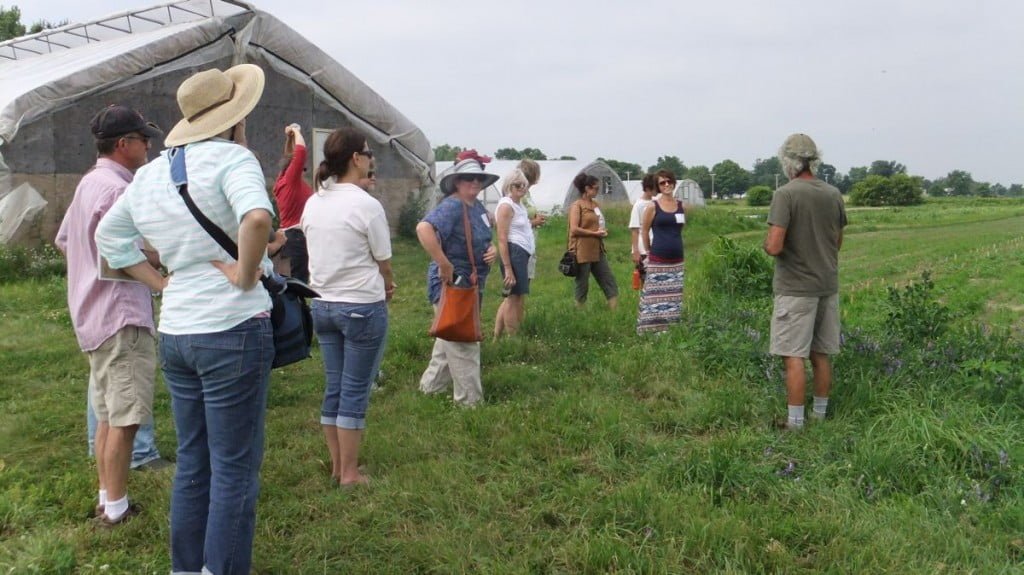
We hosted a farm tour this week for the Wisconsin Organic Advisory Council. Steve (at right) serves on the council which advises the WI Department of Agriculture on issues related to organic ag. Participants include farmers, consumers, organic advocates, business and nonprofit representatives. The group stands in front of carrot trials we’ve planted in collaboration with UW/Madison professor Erin Silva (second from right).
Veggie list and veggie notes (July 24/25, week #10, purple EOW)
Green beans, 2 lb
Broccoli, 1+ lb
Carrots, 2 lb
Kale (either green or lacinato kale), 1 bunch
Walla Walla onion, 1 large
Zucchini and summer squash, about 2.5 lb
Cucumbers, 2
Basil, several sprigs
Cherry tomatoes OR globe eggplant OR Japanese eggplant
Fresh garlic, 1 small
Next week’s box will probably contain snap beans, melon, sweet corn (?), lettuce, tomatoes, onions, zucchini, cucumbers, bell peppers, basil and more.
Fresh garlic – Refrigerate and eat soon. This young garlic won’t spoil at room temperature but will become more difficult to peel as it dries. The skins are still moist and will come off easily. At this early stage, we clean the garlic by hosing it off, and it’s still damp. We grew these heads but most of the garlic we send to you will be from John Hendrickson of Stone Circle Farm. We planted garlic ourselves this year so we can increase the amount of garlic you receive from us.
Interesting project
- On: July 16, 2014
 0
0
Last season, our tomatoes produced a bumper crop and we debated what to do with them. We sent 5 lb bags in the CSA boxes week after week. We sold bulk cases to you folks for preserving. We couldn’t bear to let them rot in the field but they were ripening very very quickly. I hunted up a small processor in East Troy called Contract Comestibles to bottle the ripe tomatoes as juice. It’s just pureed tomatoes seasoned with salt and organic onion, garlic and black pepper. We planned to send the juice in an early CSA box this year but those early boxes were full with spring crops.
This is a good moment to include it in the CSA box because you can use it as a base for soup. I made soup with sautéed zucchini, diced Walla Walla onion and minced oregano, simmered together with the juice, and topped with feta cheese. It was a quick and tasty meal with pasta. I am eager to see what Pat at Local Thyme does with it. Of course, the easiest approach is to simply drink it.
It was an interesting project for me. Farming is endlessly varied but it’s fun to tackle something new. I know a lot more about food processing now. We are curious if you consider this a valuable addition to your CSA box, and whether you think we should do this again in a bumper tomato year. Please let us know your thoughts. We’ve spanned an entire year in this box, from last year’s bottled ripe tomatoes to this year’s cherry tomatoes. I love it. Beth
Email brown-out
I am taking our children to visit family on the east coast. Steve will stay here at the farm. We ask that you limit communication with us from July 25 through August 4. Please contact us no later than noon on July 25 to ask questions, cancel a box, etc. This is an email brown-out, not a black-out. Steve will check my emails but won’t have much time to respond. I’ll be back and ready to communicate on August 4. Thanks for your help with this. Beth
Why did we sell basil last week instead of putting it in the CSA boxes?
We offered basil for sale to members last week. Several members wondered why we sold it instead of putting it in the CSA boxes. This is an excellent question.
Answer #1.
Both parsley and basil were ready to harvest, with oregano looming. We chose parsley for the CSA boxes last week because we had sent basil the week before. It takes a long time to pick those little bunches so we send one herb per week. Our expected herb sequence is basil (July 3), parsley (July 10), oregano (July 17), basil (July 24), basil (July 31). Let’s see if the plants cooperate.
Answer #2.
We have promised to sell extra basil, tomatoes and peppers to you members for preserving, when we have enough to sell. It’s a benefit of being part of our CSA. Our first priority for any crop is to provide it in your CSA boxes. When we have an abundance, we’ll offer extra for sale to members.
How do the extra produce sales work?
I will send an email to everyone when we have extra produce to sell. The email has instructions plus a link to place your order online and pay via credit card. Please order online instead of sending a request by email. It streamlines the process for us. Regular season CSA members (weekly or every-other-week) can order extra produce. A few members have asked that we give more advance warning when offering extra produce for sale. I will try to do that.
When are the next basil sales?
I hope to offer basil for sale next week (July 24/25) but won’t know until I’m sure we have enough for all the CSA boxes. Watch for an email from me mid-week.
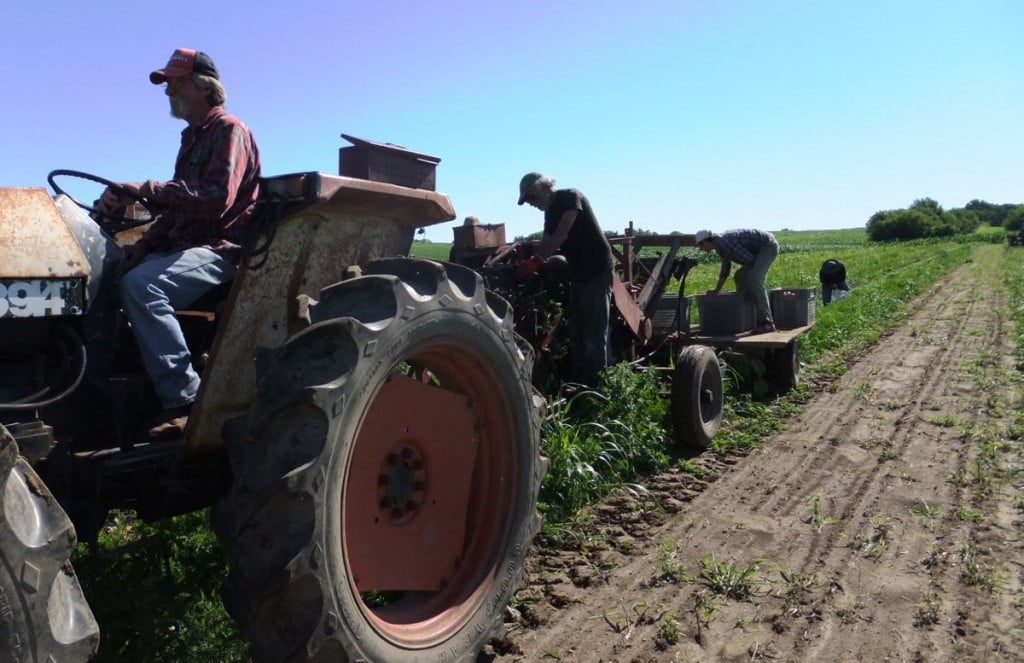
First carrot harvest of the year! From left, Larry drives the tractor, Steve guides the root harvester, John manages the carrots on the wagon and Edgar picks up missed carrots. Steve was very pleased with this first harvest.
Veggie list and veggie notes (7/17/14, week #9, green EOW)
These are our first harvests of bell peppers, oregano, carrots and beets. A few sites will get cherry tomatoes, while others will get broccoli. The cherry tomato pints are not completely full; we wanted to share these first tomatoes as widely as possible. Soon we’ll have cherry tomatoes for everyone.
- Tomato juice, 1 quart
- Carrots, 2 lb
- Beets, 1.5 lb
- Romaine lettuce
- Snap peas, 0.6 lb
- Green bell pepper, 1
- Walla Walla onion
- Zucchini & summer squash, about 2.5 lb
- Cucumbers, 2
- Oregano, 1 bunch
- Broccoli OR cherry tomatoes
Next week’s box will probably contain green beans, broccoli, carrots, kale, zucchini and summer squash, cucumbers, Walla Walla onion, garlic, basil and more.
Tomato juice – Store out of sunlight at room temperature when unopened. Refrigerate after opening. The juice is already seasoned so don’t add salt if you cook with it. I’ve listed the ingredients and nutritional information here.
Beets – Beets are excellent cooked or raw.
Storage: Cover and refrigerate. Beet roots will last for weeks. For all the cooking methods below, wash and scrub the beets but do not peel. The skins slip off easily once the beets are cooked and cooled.
Cooking beet roots on the stovetop: Slice or quarter, cover with water in a pot, and simmer until tender. This will take from 25 to 45 minutes depending on how large the beet pieces are. Drain.
Roasting beets: Wash beets, but do not peel. On a sheet of aluminum foil, put beets (halved or quartered if large), salt, pepper and a few sprinklings of water. Seal the foil packet, and roast at 400oF until tender, about 45 minutes to 1 hour. Slip off skins once cool. Microwave: Slice beets in half and place in a large microwave-proof bowl. Add ¾ inch water and cover with a plate. Microwave on high until tender, about 9-20 minutes, depending on your microwave’s power. Drain and slip off skins.
Raw: Grate raw beets for marinated salads.
Uses: Use cooked beets in cold salads, or dress simply with vinaigrette, onions, salt and pepper. Beets are also good tossed with sour cream, minced onion, fresh herbs and walnuts.
Oregano – Cover and refrigerate.
july 10 2014
- On: July 09, 2014
 0
0

Boi washes and counts fennel for this week’s box. The frilly tops are fragrant and lovely.
What should you do when on vacation?
Let’s review how to reschedule a CSA box. This is the same information we offered in our CSA Handbook this spring. Please send complete info when you ask to reschedule a box. It’s a big help. Madison members with Honeybee bread shares, please contact Mary directly to reschedule your bread.
Tipi Vacation Policy. We understand that members go on vacation. You have three options:
1. Cancel your box. Please give us one week advance notice.
2. Have a friend pick up the box for you. Make sure he/she knows how to get the box. Give him/her the instructions for your site (see 5/9/14 email from us) so they have the directions and hours, and know how to contact your site host.
3. You can reschedule up to two boxes per season. We need one week advance notice. You must choose the replacement date at the time that you cancel the box. Send us an email with …
– the *primary name for your share
– your pick-up site
– your share type (weekly or EOW/green or EOW/purple)
– the date you want to postpone
– the new date you would like to reschedule for.
*The primary name for your share is the first name listed on the check-off sheets.
Weekly members, you will receive two boxes on the rescheduled date.
Virtual tour of our two strawberry u-picks
During every farm event, I start chatting and forget to take photos. Fortunately, you folks took pictures and are willing to share. Thank you! Here is a sampling. We were lucky that the weather stayed clear during both u-picks. As you can see in the first photo, storm clouds blew in just as the first u-pick ended.
Veggie List and Veggie Notes (7/10/14, week #8, purple EOW week)
You’ll notice a switch to summer vegetables. We hope you enjoy this box. We think it’s an especially nice one.
Cabbage, 2 to 3 lb
Swiss chard, 1 bunch
Snap peas, 3/4 lb
Snow peas, 1/4 lb
Both types of peas are in one bag.
Fennel with tops, 1
Zucchini & summer squash, 2 to 3 lb
Cucumbers, 3
Red bibb lettuce, 1 tiny
Walla Walla onion, 1
Parsley, 1 generous bunch
Next week’s box will probably contain beets with greens, carrots, peas, Walla Walla onion, zucchini, cucumbers, kale, herbs and more.
Cabbage – This is another head of salad-type cabbage. These have thinner, more tender leaves than the usual green cabbage. Great in salads and slaws but can also be cooked.
Fennel (large vegetable with a fat bulb and lacy fronds) – Fennel is a ‘swing vegetable’; it can be used raw or cooked. Clean well and slice as thinly as possible for use in raw salads. It is good simply prepared with olive oil, lime or lemon juice, salt and shaved parmesan cheese. Cooking softens and sweetens fennel, and mellows its anise flavor. Both the bulb and leaves are edible. Here are ideas from Alice Water of Chez Panisse about how to use fennel: ‘It’s strong anise characteristic seems to suit fish particularly well. … We use fennel all the time. We add the feathery leaves to marinades for fish and to numerous salads, sauces and soups and we use them as a garnish, too. … The bulbs are sliced and served raw in salads in various combinations with other vegetables, parboiled for pastas; caramelized and served as a side dish; braised whole; or cooked in vegetable broths & fish stocks.”
Red bibb lettuce – These heads are tiny but very nice. We harvested them young because it’s risky to leave them in the field in wet weather. They should be useful in a mixed salad or as a bed for marinated vegetables.
Walla Walla onions – These are sweet onions, like Vidalias. Wonderful raw or lightly cooked. This week’s onions are unusually plump for this time of year.
What do farmers do during rainy weather?
- On: July 02, 2014
 0
0
It’s been too wet for field work this week. We harvest your veggies rain-or-shine, but can’t take tractors in the fields when the ground is too muddy. Steve spent his time buying more irrigation pipe. How ironic is that, to work on irrigation during a monsoon? We will enjoy the new pipe; it will allow us to irrigate five big carrot fields (over 3 acres) at once without moving pipe. This is a big improvement. Of course, the carrots are not planted yet because the ground is too wet.

Steve with our new irrigation pipe.
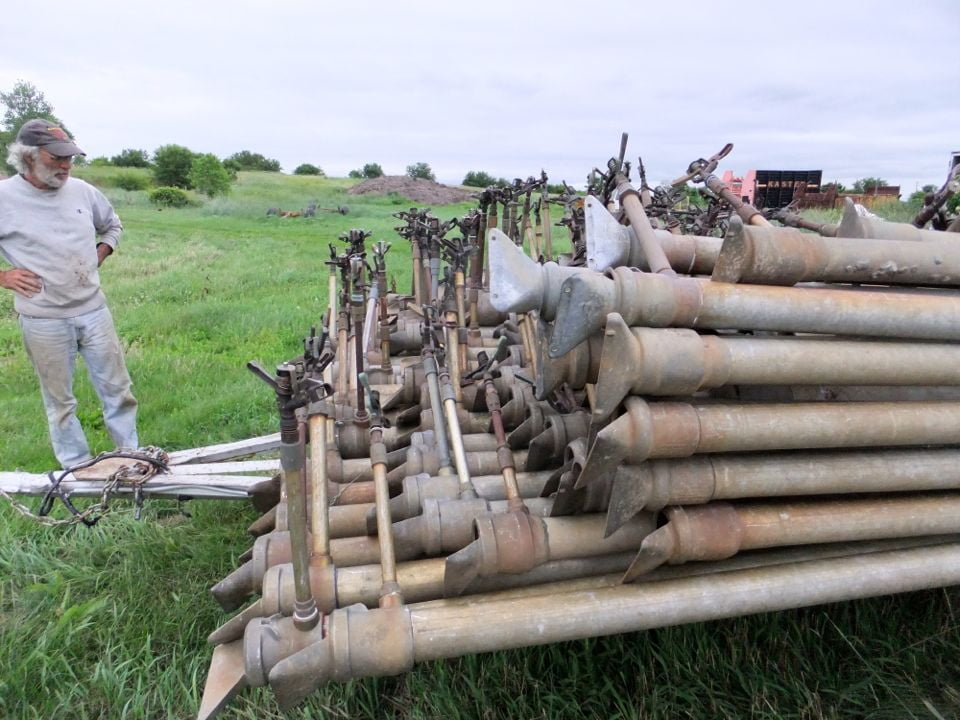
The business end of the pipe although, as Steve says, “it’s really good to have both ends.”
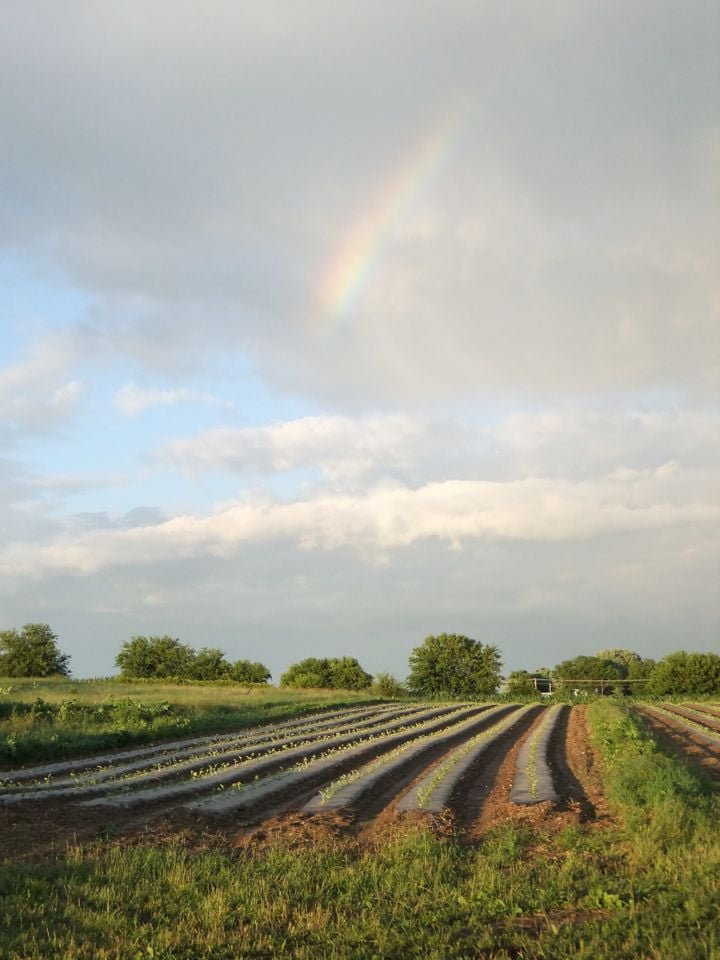
A sunny moment between rain storms.
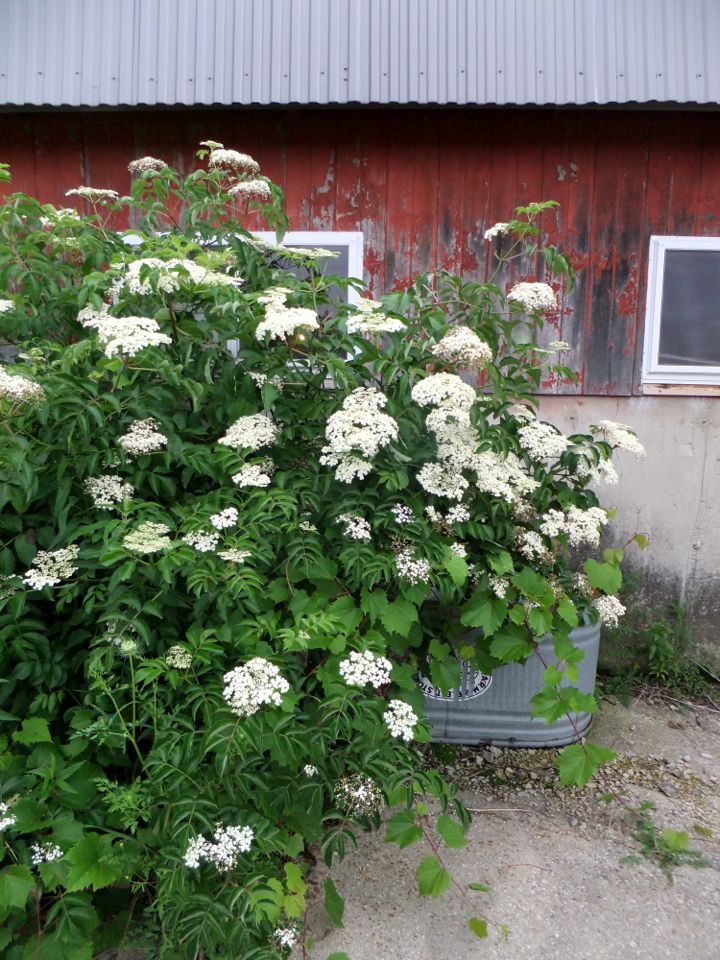
The elderberry bushes are spectacular this year.
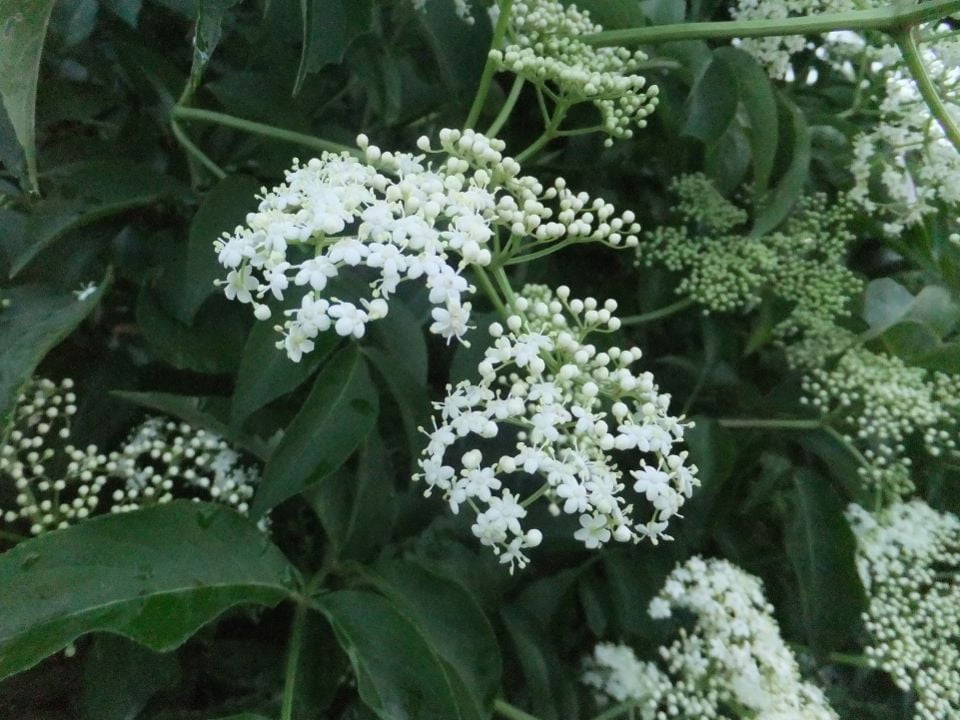
Every bride should carry lacy elderberry blossoms, never mind the funky smell.
Veggie List and Veggie Notes (week #7, green EOW)
We enjoyed the strawberry u-pick on Sunday. Lots of members came to pick berries and wander the farm. Fortunately, the u-pick berries ripened during somewhat drier weather. Sadly, pounding rainstorms on Sunday night and Monday damaged the late berries. That ends our strawberry season.
We’ve sent a lot of squash and cucumbers because the plants were remarkably productive this week. Our bees did not visit (or pollinate) our squash plants for a long time because of rainy or windy weather. Once the plants got pollinated during dry spells, they exploded with rapid squash growth. Same thing happened with the cucumbers. Grilled squash and cucumber salad are great 4th of July dishes. Enjoy!
Snap peas, 1.4 lb
Broccoli, 1 head
Zucchini & summer squash, 3 – 3.5 lb
Cucumbers, 4
Collard greens, 1 bunch
Green leaf lettuce, 1 small
Kohlrabi, 1
Scallions, 1 large bunch
Basil, 1 sprig
Next week’s box will probably contain cabbage, zucchini, fennel, parsley, cucumbers, lettuce, scallions OR Walla Walla onions, and more.
Basil (curly-leaved sprig) – This is the variety ‘Napoletano.’ The leaves are larger and more frilly than most basils. We like this variety because the its leaves remain tender and flavorful even as the plants mature. Basil will blacken if stored in the refrigerator. It is best stored at room temperature with the cut ends in water, for example in a glass or teacup. Give the stem a fresh trim. You will receive one sturdy stem this week. We snipped these sprigs to shape the plants. They are a bit tattered from the recent rains but taste (and smell) great.
Green leaf lettuce – The lettuce are quite small. We harvested them young while they are still good. It’s a good strategy during wet or hot weather.
We grabbed our opportunity.
- On: June 25, 2014
 0
0
The recent rains have slowed our farm work. Even pollination is slow; bees don’t leave their hives in rainy weather. No bee visits to the zucchini blossoms = no zucchini. There was a break in the weather today, a chance to catch up on our stalled field work. The soil was just dry enough today for transplanting.
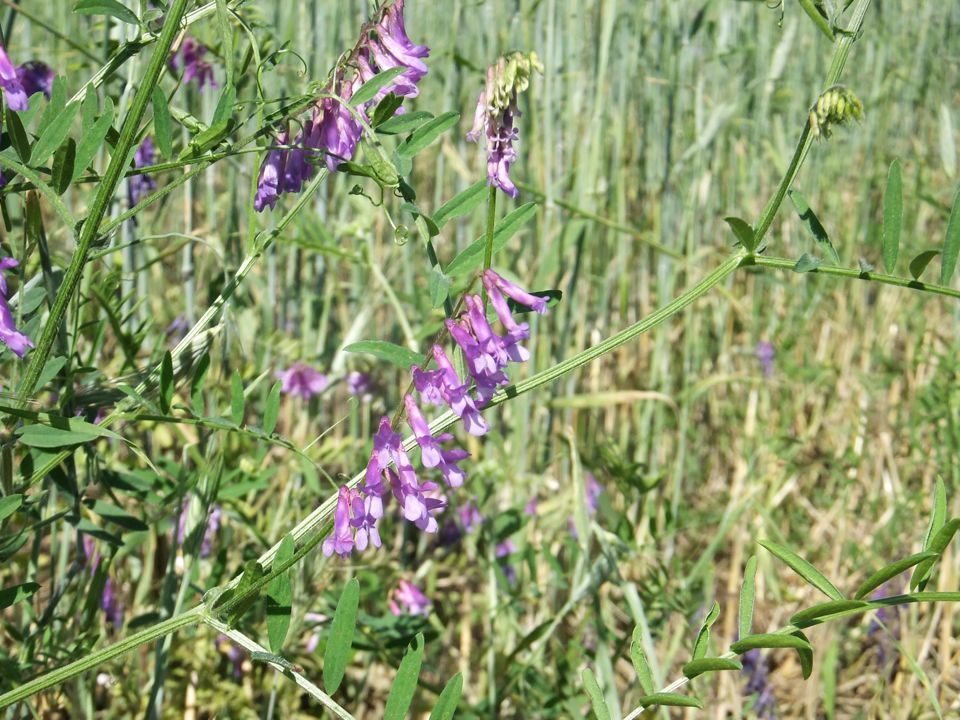
We mowed this hairy vetch cover crop weeks ago but it’s been too wet to till into the ground. Now it’s regrown and flowered again. We need to mow a second time, till, then let the soil rest so we can plant carrots in early July.
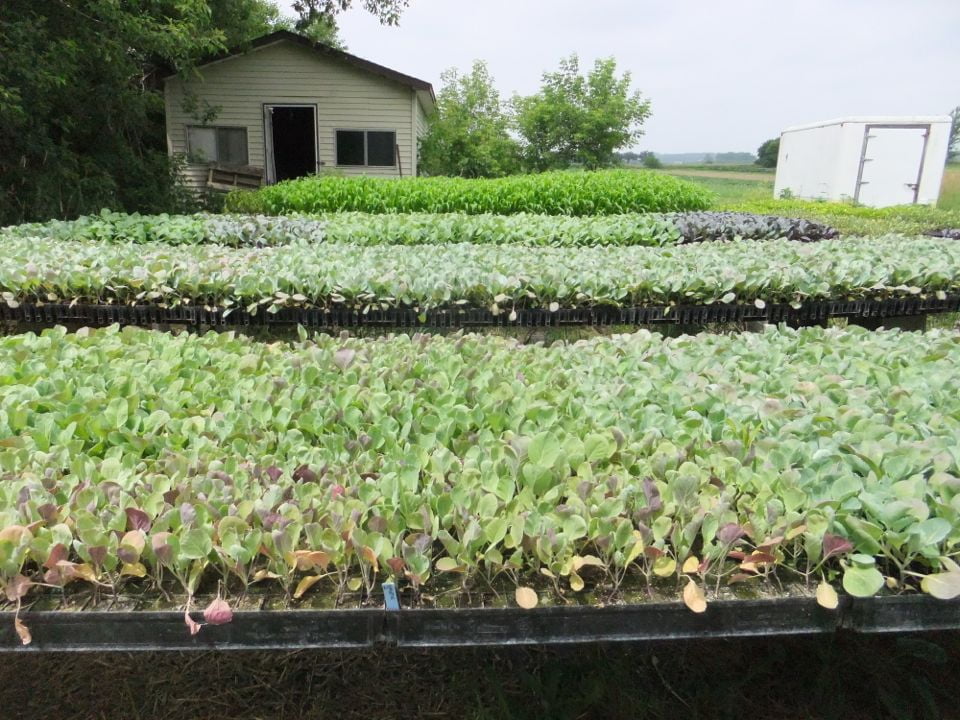
These seedlings are desperate to be planted in the ground.
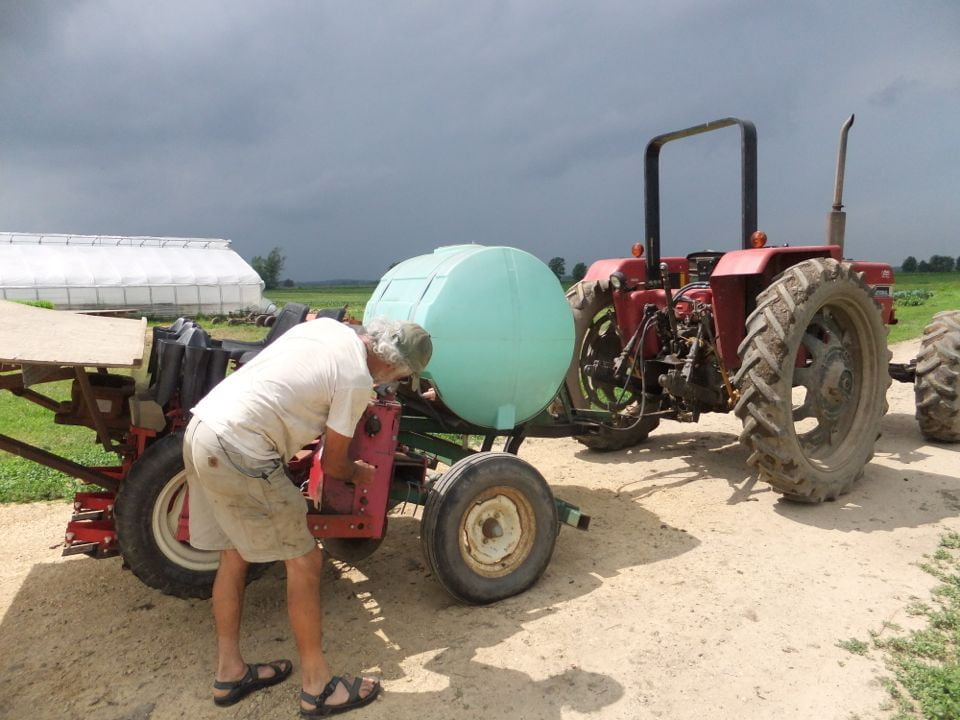
Steve prepped the transplanter as a storm approached.
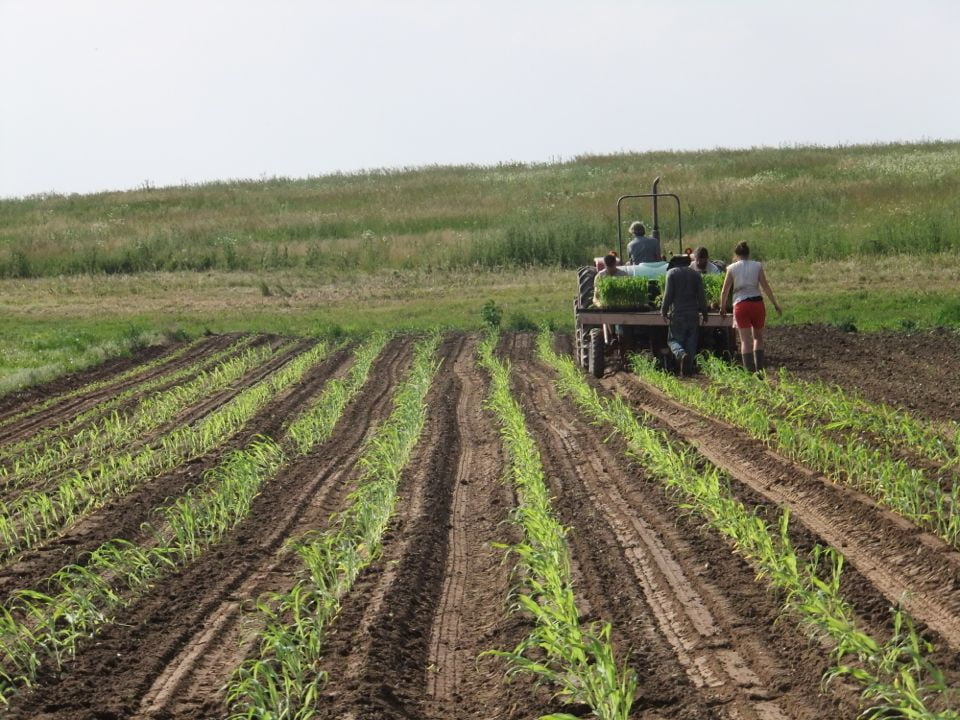
The main storm missed us, sliding by to the west. We waited out a 20 minute shower, then the sun returned. The crew got the next sweet corn planting in the ground. We will all reap the reward in August.
Strawberry U-Pick
See our emails for details of our next berry picking.
How to flatten your CSA box.
Let’s review how to flatten your empty CSA box. We need to re-use these expensive boxes many times, but find that many boxes are getting ripped. It’s a skill to learn! Please watch Steve’s demonstration in this YouTube video. Thank you for your help with this.
- Hold the box at waist height, with the bottom of the box facing up.
- The first step is to loosen the two shorter flaps.
- Grasp the edge of the short flap closest to you and PULL TOWARD YOURSELF. The flap will bend at its natural crease.
- Do not PULL UP on the flap or the tabs will rip, ruining the box.
- The flap can now be pulled loose.
- Repeat with the other short flap.
- Unfold the two long flaps.
- Repeat for the top of the box if it is closed.
- Now collapse the box so it is flat. Please stack neatly with the other empty CSA boxes.
- Thank you!
Veggie List and Veggie Notes (6/26/14, week #6, purple EOW)
You should eat your strawberries right away. They are very juicy because of all the rain, and might spoil quickly. The rain didn’t affect any of the other veggies that we’re delivering this week.
Strawberries, 1 quart + 1 pint
Asparagus, 0.6 lb
Mixed zucchini and summer squash, about 2 lb
Snap peas, 0.75 lb
Snow peas, 0.25 lb
(The snap and snow peas are combined in one bag.)
Lacinato kale OR Napa cabbage (You will receive one of these)
Daikon radishes, 2 or 3
Rhubarb, 1.5 lb
Scallions, 1 large bunch
Garlic scapes
Next week’s box will probably contain strawberries, peas, lettuce, zucchini, cucumbers, broccoli, basil and more.
Strawberries – Eat these right away.
Zucchini and summer squash – This is the first picking, just in time for the official start of summer. The first squash are often oddly shaped, as the bees haven’t settled into pollinating them thoroughly.
Snap peas have plump pods and snow peas are flatter. You need to remove the strings from both types. See instructions in last week’s newsletter.
Lacinato kale (bunch of ruffled dark green leaves) – This is a popular kale, also known as ‘dinosaur kale.’
Napa cabbage (a pale green head of soft-leaved cabbage) – This Asian vegetable can be eaten raw in salads, or cooked in simple stir-fries. Napa stores very well. Cut off wedges as needed and keep the rest covered and refrigerated, and it will keep for several weeks. Peel off the outer layer and it will be ready to use. Here are a few preparation ideas from the ‘Asparagus to Zucchini’ cookbook.
– Chop raw napa into green salads.
– Substitute napa in traditional coleslaw.
– Chinese cabbage cooks quickly. Steam 3-5 minutes, or until leaves are wilted down but remain slightly crisp.
– Substitute napa cabbage for common cabbage in recipes, but reduce the cooking time by 2 minutes.
– Napa cabbage is the main ingredient in egg rolls. Try making an egg roll mixture to eat as a cooked side dish instead of preparing time-consuming egg rolls.
Daikon radish (slender white roots) – These Asian radishes are good cooked or raw. We often make a sliced radish salad, with Asian-style dressing (rice vinegar, mirin, sesame oil, soy sauce, minced garlic). Even a brief marination mellows the radish’s sharpness.
Next steps
- On: June 18, 2014
 0
0
Let’s review our CSA delivery schedule for the week of July 4.
That’s the next green EOW delivery.
– Evansville, Madison, Middleton and Oregon deliveries will be on Thursday, July 3, as expected.
– Milwaukee area and Janesville deliveries will be on Thursday July 3 to avoid the July 4 holiday.
Strawberry U-Picks
Please read our emails for info about upcoming strawberry u-picks here at the farm.
Food Preservation Volunteers Needed at the Goodman Center in Madison
Tipi member Amy Mach coordinates this program, which allows you to learn new skills or put your current preservation skills to good use. Amy writes “Help preserve nature’s bounty as a volunteer in the Goodman Community Center’s food preservation program. No experience necessary! The Community Center is located on the eastside of Madison. The produce you preserve will fill the shelves of the Fritz food pantry with healthy local food. Last year, volunteers in this important program were able to can, dehydrate and freeze 3,000 pounds of local fruits and vegetables, helping to feed the 100+ families per week that our food pantry supports year-round. Enjoy a flexible schedule of one 3-4 hour shift per week. Choose between daytime, evening and weekend opportunities that fit your calendar!”
Attend one of their informational sessions. Each session is 2 hours long and includes new volunteer orientation.
June 19th at 3pm
June 30th at 5pm
Please RSVP to Amy Mach, amymach(at)goodmancenter.org or 608.241.1574 x227
Farm Progress
The tornados and severe storms missed our farm this week. I hope all of you are faring OK, and the storms missed you too.
We uncovered our zucchini and cucumber fields last week. We keep the plants under floating row cover in early spring to protect them from frost and to speed their growth. Of course, weeds also grow faster under row cover. They’re a cover crop as long as they don’t set seed, right? We tackled the weeds on Monday before the big storms. The squash plants are uncovered, the bees can pollinate the blossoms, and we’ll have squash for you next week. Beth
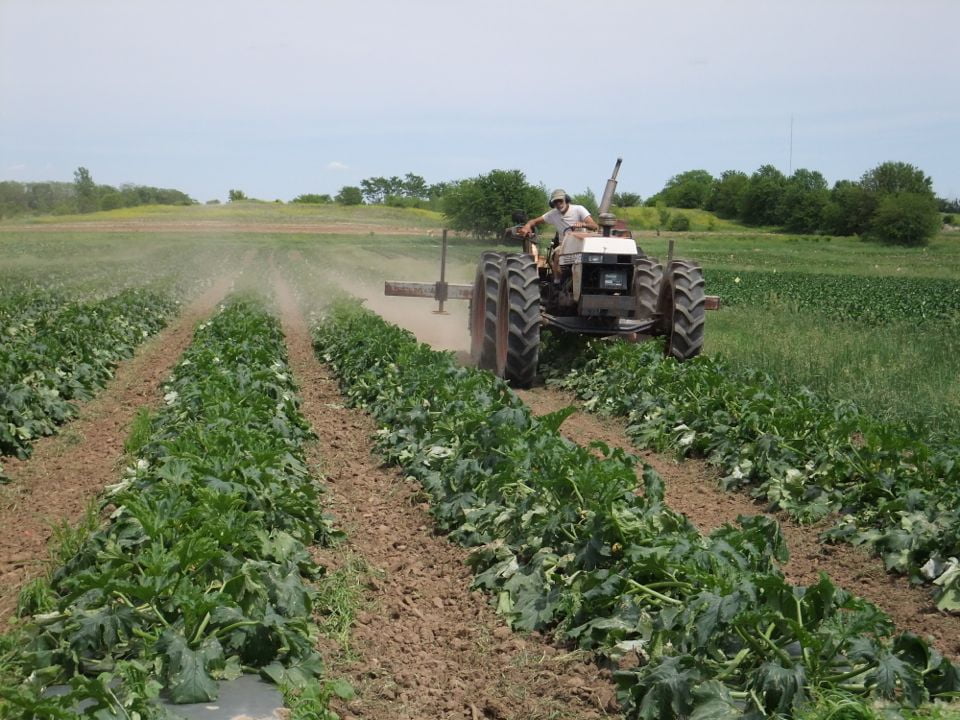
Steve cultivates the zucchini field. He moves along quickly. Steve and Michael were cultivating at the same time on Monday, a race to get the work done while the fields were still dry.
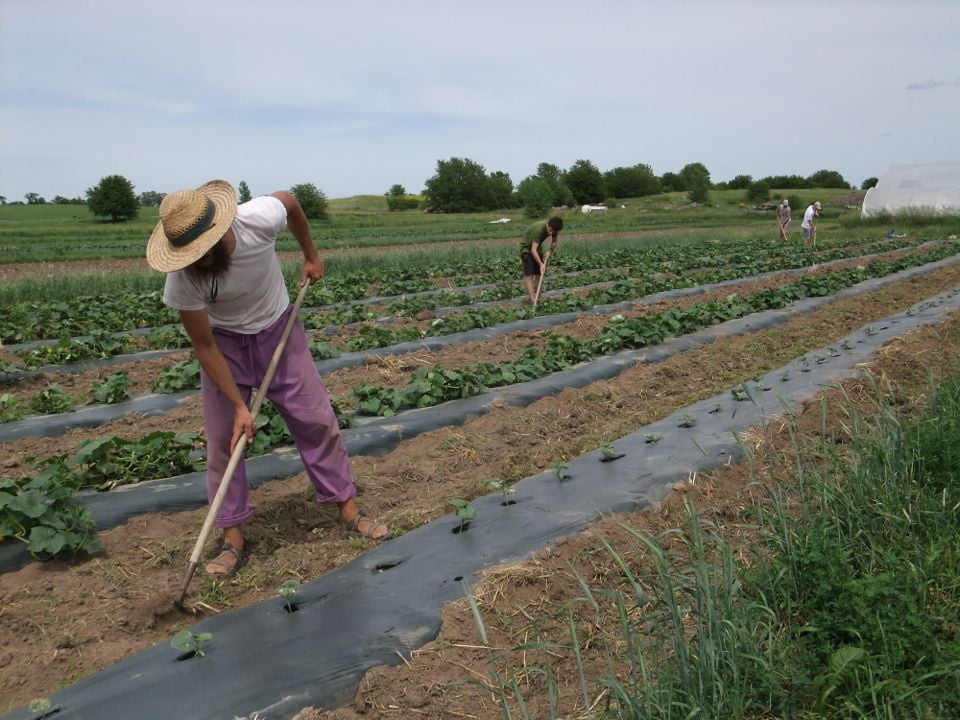
Clint, Peter and others follow up with hoes in the cucumber field. The tractor gets most weeds but never all of them.

Billy (and others) pick your strawberries.
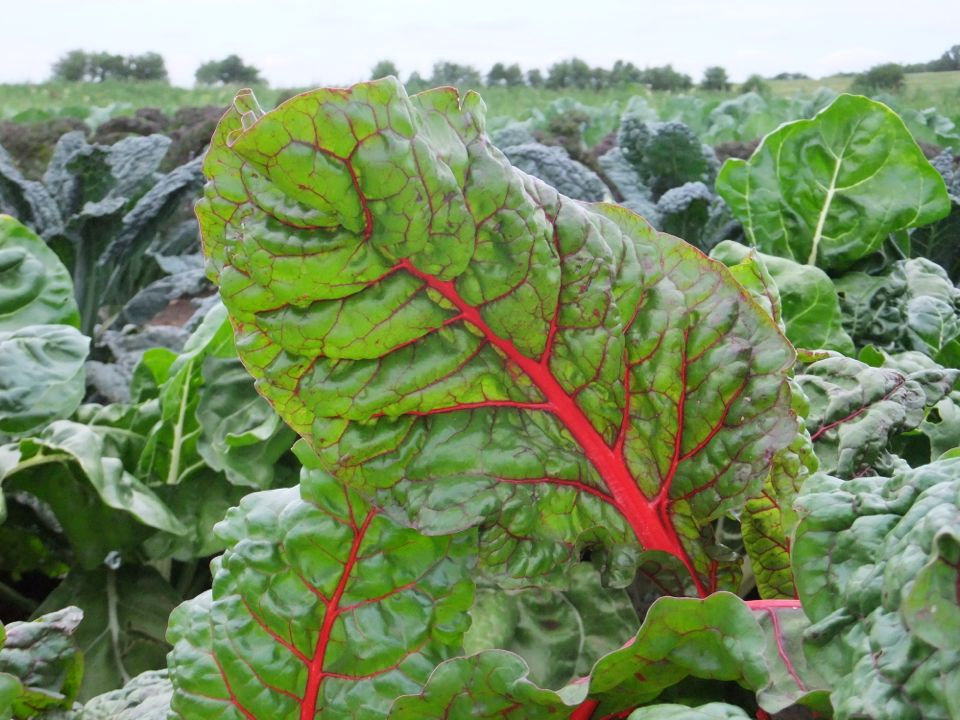
Red Swiss chard. Steve plants rows of red, pink, yellow and white chard next to each other so we can easily make colorful bunches. This is its natural color, not Photoshopped.
Veggie List and Veggie Notes (6/19/2014, week #5, green EOW)
Strawberries, 1 quart or 2 pints
Asparagus, 1 lb
Snap peas, 1 lb
Snow peas, 1/4 lb
(The snap and snow peas are combined in one bag.)
Swiss chard, 1 medium bunch
Green leaf lettuce, 1
Green cabbage, 1, about 2 to 2.5 lb
Scallions, 1 large bunch
Garlic scapes
Next week’s box will probably contain strawberries, zucchini or summer squash, peas, napa cabbage, daikon radish, scallions, garlic scapes, rhubarb and more.
Strawberries! We’ve been waiting for these.
♦ Strawberries are perishable. Ripe berries should be eaten immediately, or stored in the refrigerator. Most berries are quite clean. If you want to clean your berries, rinse gently. Don’t soak them, just rinse. Do not be concerned if you receive a partially-filled container. Sometimes we fill them partially in order to distribute berries to all the members.
♦ Please recycle your strawberry containers this year. We no longer collect them for re-use.
Snap peas (plump pea pods) – These peas should be eaten pod and all. They are delicious raw, or very lightly cooked or stir-fried. They might need a quick rinse to remove faded gray blossoms. Store in the refrigerator. Here’s how to remove the strings from the snap peas. Snap off the stem end and pull the string down the concave side of the pod (the inward-curing side). Throw away the string and eat the pod.
Snow peas (flat pea pods) – These are excellent stir fried or in raw salads. The thicker pea pods will usually have two strings along the edges. Remove them when you snap the stem off.
Swiss chard (pretty bundle of greens with mixed-color stems) – This is a close relative of spinach, but requires a bit more cooking. Use as a substitute in any recipe that calls for spinach, just cook the chard a little longer. Both stems and leaves are delicious. The stems requite longer cooking, so cut them free from the leaves when preparing. That allows you to cook the stems longer.
Cabbage – This ia a nice salad-type that we grow in summer. Don’t you love the pointy shape? It has thinner, more tender leaves than the usual green cabbage. Great in salads and slaws but can also be cooked. Most of this week’s cabbage weigh between 2 and 2.5 lb.
Garlic scapes (curly green things) – Garlic scapes grow at the top of garlic plants. They look like flower buds but are actually clusters of tiny bulblets. It’s important to snap off the young scapes to direct the plants’ energy into forming garlic bulbs underground. Use scapes as a substitute for garlic cloves. They can be minced, mixed with olive oil, and added to stir fries or simple pasta dishes. The scapes can be sautéed, but will not brown like garlic cloves. Expect them to retain their crunch even when cooked, and to be milder than garlic cloves, closer in pungency to the green garlic we’ve sent.
Most of the scapes are from John Hendrickson of Stone Circle Farm who grows organic garlic for our CSA. We planted a small field of garlic last fall, providing more scapes.
Empty greenhouses, full fields
- On: June 11, 2014
 0
0
We finished an intense burst of field work last week. Under threat of coming rain, Steve and the crew rushed to transplant our seedlings into the field. We emptied two full greenhouses, a total of 50,000 plants. Everyone worked so hard. We have reviewed and practiced our hand signals this spring for communication with our tractor drivers. For example, we circle a finger in the air to say “speed up.” Simone looked back from the tractor during pepper transplanting. Clint was planting so quickly with both hands that he couldn’t even manage the hand signal, just a big grin and a nod of the head. Sturdy pepper seedlings can handle that kind of speed. We slow down for melons and cucumbers because their roots are fragile and they need gentle handling. Handle them roughly during transplanting and many plants will die.
Steve reviewed the accomplishments at the end of the week, thanked everyone, and announced “Of course, all of those fields will need weeding in 10 days.” That was a sobering moment. Fortunately, the work goes quickly with a large group of people. I asked Steve why we were able to complete so much in one week. He said it was the cohesive crew, terrific plants, cooperative weather. Personally, I think it was the new t-shirts.
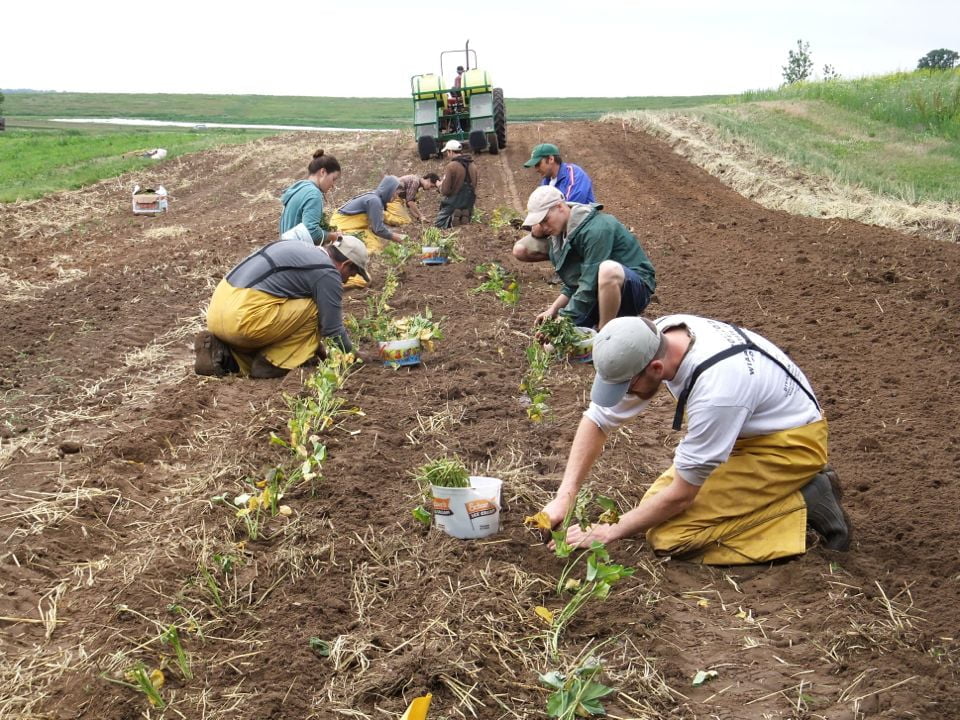
See what we can accomplish as a group? Planting sweet potato slips.
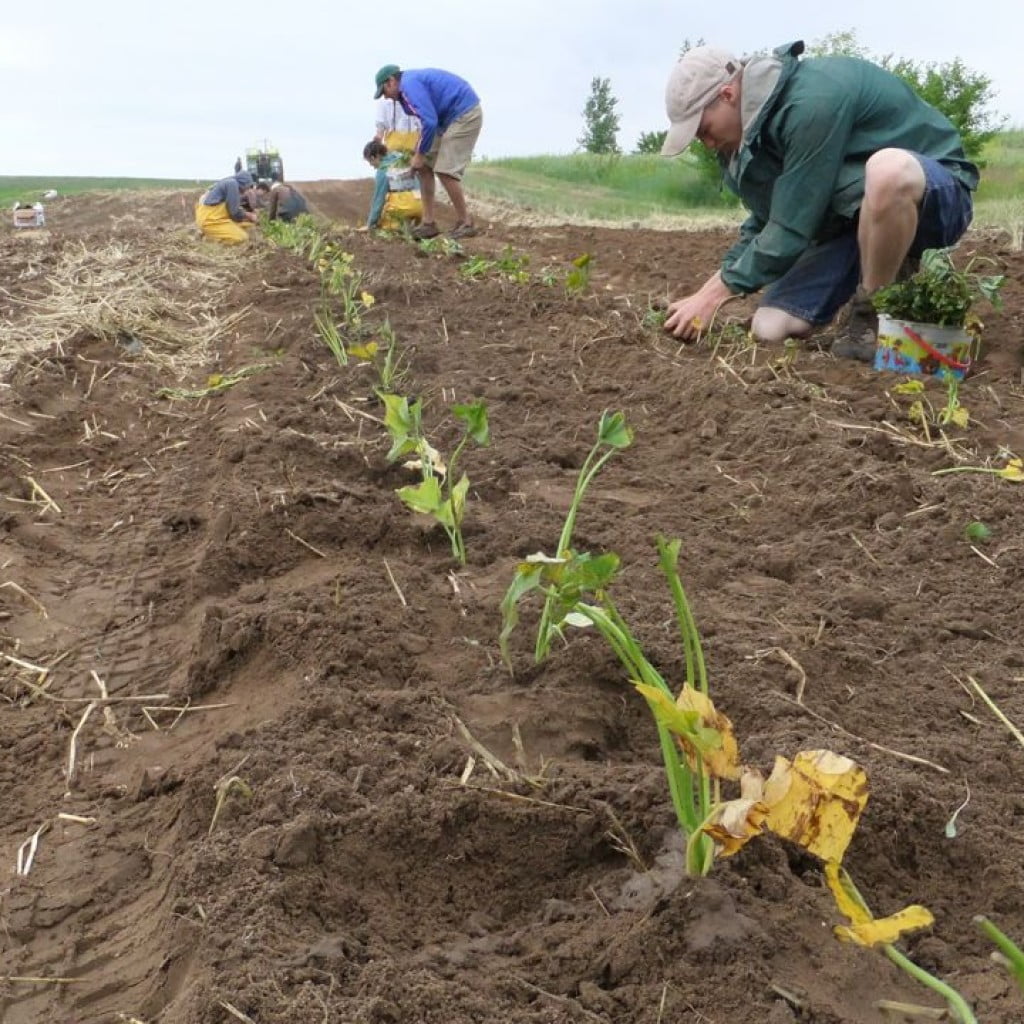
These tiny cuttings will grow into ten foot vines.
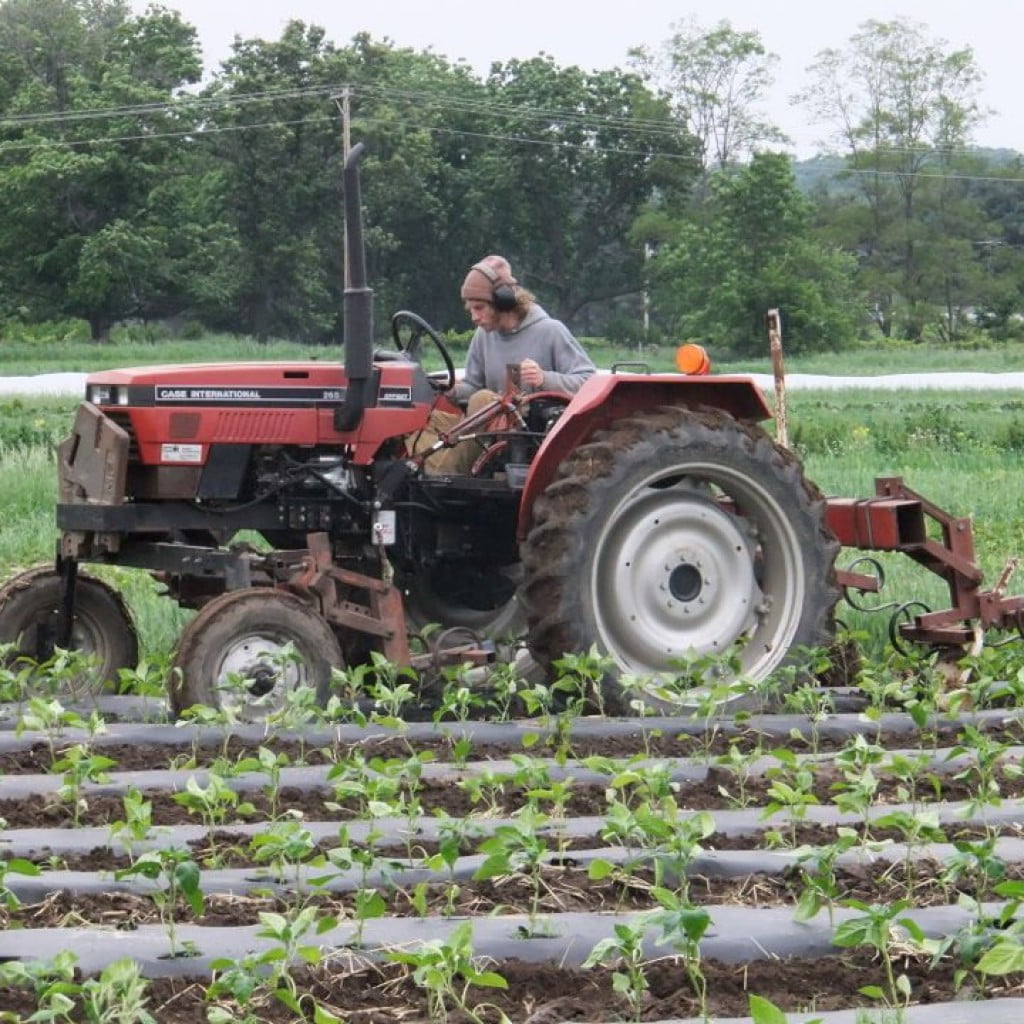
Steve is teaching Michael to cultivate. Here, he cultivates weeds at the edge of plastic mulch in our pepper fields. This job takes great concentration.
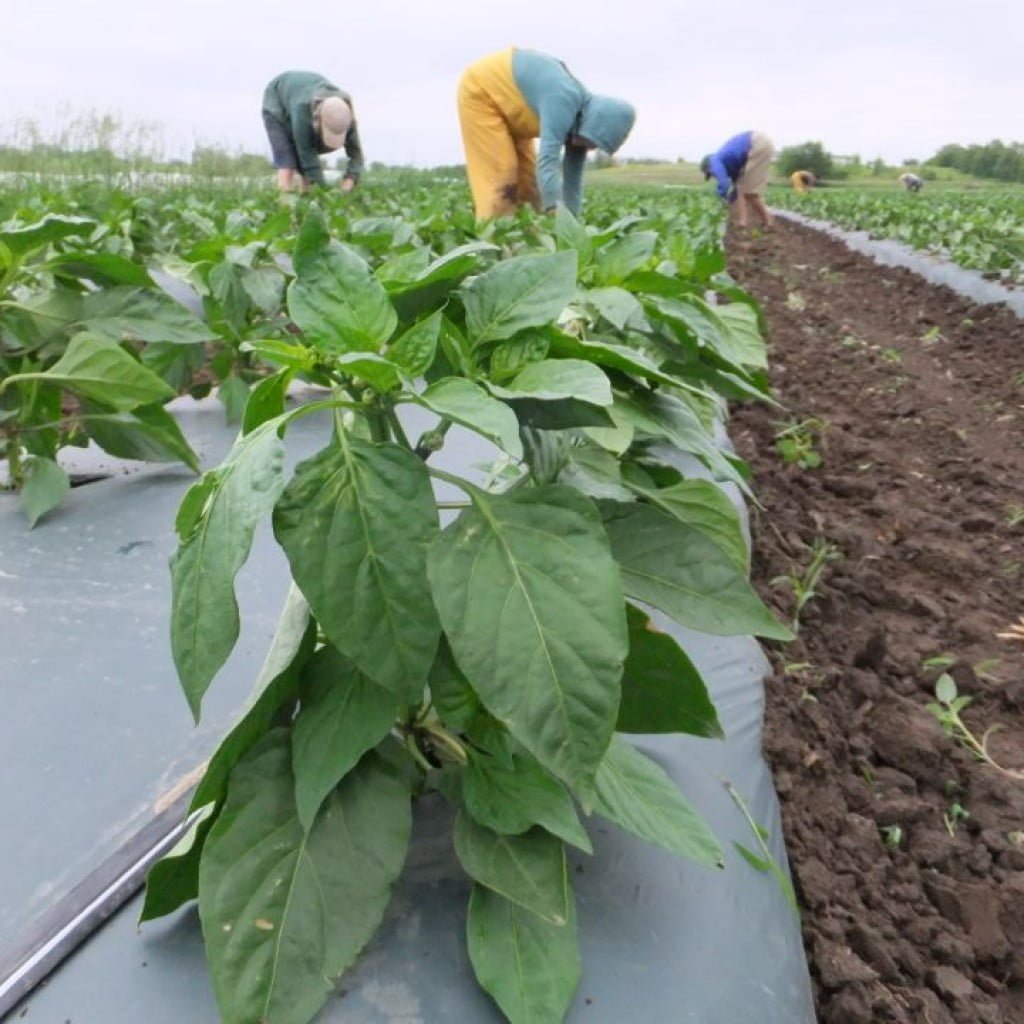
The pepper plants are thriving.
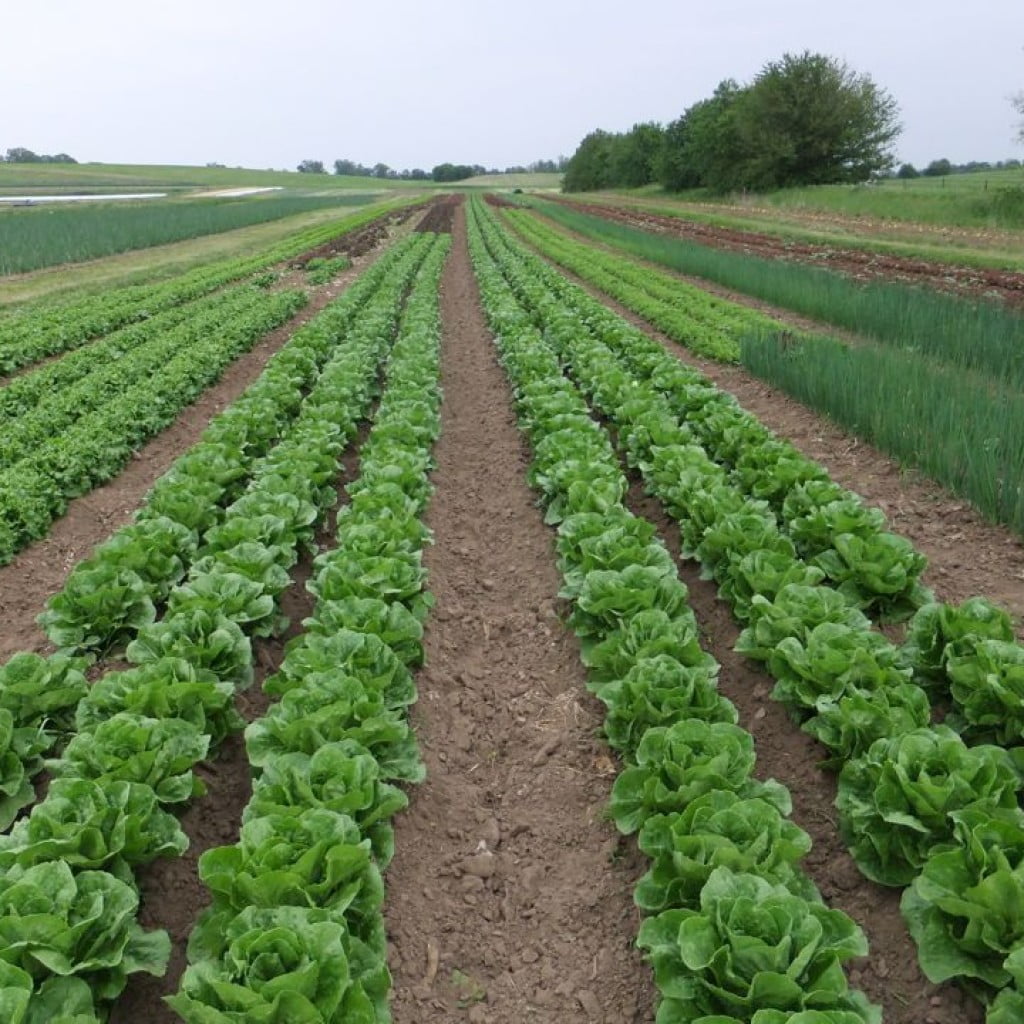
All the colors are so lovely right now. From left, endive, lettuce and scallions, ready to harvest.
A Wrinkle in Local Thyme (LT) registration
Pat wants you to know that each member’s registration will end one year after you first registered. LT has worked for some of you without renewal this year, but will lapse on the anniversary of last year’s registration. Send me an email titled “LT please” if you need the registration instructions and code.
Veggie List and Veggie Notes (6/12/14, week #4, purple EOW)
This is the year of giant spring vegetables. We’ve had great growing weather and everything is big. Quality remains excellent. Again, we encourage you to wash your produce carefully (especially asparagus, lettuce, escarole and spinach) because of the recent rains.
Asparagus, 1.3 lb
Red leaf lettuce, 1 head
Spinach, 1 large bunch, about 1.75 lb
Escarole, 1 head
White salad turnips, 1 bunch
Scallions, 1 bunch
Kohlrabi, 1
A few members will get a small head of broccoli.
Next week’s box will contain PEAS plus a few incidentals like asparagus, chard or kale, lettuce, scallions, garlic scapes, and more.
Escarole (large head of wavy green leaves) – This member of the chicory family can be eaten raw or cooked. Its slightly bitter flavor is a good addition to mixed salads. It is excellent cooked alone or mixed with other greens. It cooks quickly, but not as quickly as spinach. Refrigerate.
Kohlrabi (pale green globe with crisp white interior) – Kolrabi is an unusual vegetable that I enjoy introducing to new CSA members because almost everyone likes it. Crunchy and sweet, it’s a great addition to salads.
Storage: Kohlrabi bulbs will store for a month in the refrigerator.
Uses: Kohlrabi are good peeled and eaten out of hand, or added to sandwiches. It is good mixed into salads, or prepared as a salad on it’s own. You can grate it, slice it, or cut it into matchsticks. It’s also good cooked. If you have it, the Asparagus to Zucchini cookbook has a long list of kohlrabi suggestions.
Creative woman
- On: June 04, 2014
 0
0
Longterm Tipi farmhand Maggie Schley brought special gifts to work last week. She hauled out a suitcase during our morning meeting and presented everyone with new Tipi farm shirts she designed. She selected a special shirt for each person. Mine’s a lovely shade of green! This creative woman spins, weaves, knits, shellacs walls with onion skins, preserves tons of food, and even knit her own wedding dress. Thank you Maggie!
from left, Maggie shares new shirts with David, Steve, Kerry, Bonnie, Tristan and Michael.
Kerry (right) models Maggie’s (left) new farm shirt.
The t-shirts are printed with “Water On! Tipi Produce 2014.” Maggie’s had this design in mind for years. The phrase “water on” means a lot on our farm. It’s the first thing we say during the first outside job every spring. We use mechanical transplanters when planting our greenhouse-grown plants into the field. When the riders on the transplanter are ready for the tractor driver to move, they holler (OK, scream at the top of their lungs) “WATER ON!” It’s a sign that the water valve is open and gushing and it’s time to get moving.
From left, Larry, Maggie and Michael ride the transplanter while Kerry makes sure the seedlings are at the proper depth. The tractor pulling the transplanter is hidden to the rear. You can just see its tall roll bar.
The photo above was taken April 9, the day we transplanted the lettuce you will receive this week. Those are Romaine seedlings in the photo. Here they are now, festooned with field pennycress. No, we didn’t send the pretty weeds along with the lettuce this week.
It’s time to deposit the June 1 checks.
Many of you paid us with checks dated June 1. I will deposit the checks this Friday June 6.
Veggie List and Veggie Notes (6/5/14, week #3, GREEN EOW)
The rain was welcome this week, but splashed soil into the vegetables again. Everything needs extra washing, especially lettuce, spinach and asparagus. Dunk repeatedly in cold water until the water remains clean.
Asparagus, 1.3 lb
Spinach, 1 bunch, about 2 lb total
Romaine lettuce, 1 large
White salad turnips, 1 bunch
Mustard greens, 1 medium bunch
Green garlic, 1 small bunch
Cilantro, 1 small bunch
Next week’s box will probably contain asparagus, spinach, lettuce, white salad turnips, escarole, scallions and more.
Asparagus – Wash this asparagus well to remove grit.
Spinach – We usually tell you if the spinach is “salad-quality” or “cooking quality.” “Salad-quality” spinach is thin-leaved and tender, and shrinks substantially when cooked. “Cooking-quality” spinach is thicker-leaved and shrinks less during cooking. This week’s spinach is definitely salad-quality but we encourage you to use both ways because we are sending so much. The spinach has grown well this spring! Steam, chop and freeze any extra. You’ll be glad to have it ready to add to soups, casseroles, etc.
Romaine – Well, these are enormous. This is really nice Romaine; it was an enthusiastic grower this week. It’s time to make Caesar’s Salad.
White salad turnips – I know that returning members look forward to these sweet and delicious turnips, which taste nothing like the turnips that we harvest in fall.
– Storage: Cover and refrigerate.
– Uses: Both the turnip roots and tops are edible. Slice the sweet roots and add to salads. The roots can be cooked and are especially good when lightly sauteed in butter. Stir as little as possible so they brown on at least one side. The turnip greens are excellent cooked. Treat them like mustard greens.
– Our favorite use: Slice the roots very thinly and combine with a mixture of rice vinegar, mirin, soy sauce, sesame oil. Eat immediately or marinate.
Mustard greens – These spicy greens are so young and tender that you can use them raw in salads. They are excellent cooked until wilted, but will shrink considerably.
Green garlic – Last fall, we planted garlic cloves that grew into the stalks we’ve sent today. If left to grow until mid-summer, the slim white bulb on this week’s garlic would divide and form the usual cluster of cloves in a garlic bulb. The bunches are small this year. Remember the poor garlic crop in the Midwest last year? We could only obtain tiny heads of garlic to plant in fall. Small garlic bulbs lead to small green garlic bunches.
– Green garlic is more pungent than scallions, so slice thinly and use sparingly when raw. It mellows when cooked. Chop and add to any cooked dish that would benefit from garlic. Use the white bulbs and pale green stems. Avoid the dark green stems and leaves, as these are fibrous.
Cilantro – This herb is good in salsa, chutneys and salad dressings, or added to stir-fries. Used in Mexican, Asian and Indian cooking.


